Biography:Carl Friedrich Gauss
Carl Friedrich Gauss | |
|---|---|
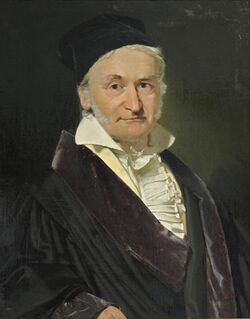 Portrait by Christian Albrecht Jensen, 1840 (copy from Gottlieb Biermann, 1887)[1] | |
| Born | Johann Carl Friedrich Gauss 30 April 1777 Brunswick, Principality of Brunswick-Wolfenbüttel, Holy Roman Empire |
| Died | 23 February 1855 (aged 77) Göttingen, Kingdom of Hanover, German Confederation |
| Alma mater |
|
| Known for | Full list |
| Spouse(s) |
|
| Children | 6 |
| Awards |
|
| Scientific career | |
| Fields | Mathematics and sciences |
| Institutions | University of Göttingen |
| Thesis | Demonstratio nova... (1799) |
| Doctoral advisor | Johann Friedrich Pfaff |
| Doctoral students |
|
| Other notable students |
|
| Signature | |
 | |
Johann Carl Friedrich Gauss (German: Gauß [kaʁl ˈfʁiːdʁɪç ˈɡaʊs] (![]() listen);[2][3] Latin: Carolus Fridericus Gauss; 30 April 1777 – 23 February 1855) was a German mathematician, geodesist, and physicist who made significant contributions to many fields in mathematics and science. Gauss ranks among history's most influential mathematicians and has been referred to as the "Prince of Mathematicians".[4]
listen);[2][3] Latin: Carolus Fridericus Gauss; 30 April 1777 – 23 February 1855) was a German mathematician, geodesist, and physicist who made significant contributions to many fields in mathematics and science. Gauss ranks among history's most influential mathematicians and has been referred to as the "Prince of Mathematicians".[4]
Gauss was a child prodigy in mathematics. While still a student at the University of Göttingen, he propounded several mathematical theorems. Gauss completed his masterpieces Disquisitiones Arithmeticae and Theoria motus corporum coelestium as a private scholar. Later he was director of the Göttingen Observatory and professor at the university for nearly half a century, from 1807 until his death in 1855.
Gauss published the second and third complete proofs of the fundamental theorem of algebra, made contributions to number theory and developed the theories of binary and ternary quadratic forms. He is credited with inventing the fast Fourier transform algorithm and was instrumental in the discovery of the dwarf planet Ceres.[5] His work on the motion of planetoids disturbed by large planets led to the introduction of the Gaussian gravitational constant and the method of least squares, which he discovered before Adrien-Marie Legendre published on the method,[6][7][8][9] and which is still used in all sciences to minimize measurement error. He also anticipated non-Euclidean geometry, and was the first to analyze it, even coining the term.[10][11][12] He is considered one of its discoverers alongside Nikolai Lobachevsky and János Bolyai.[13]
Gauss invented the heliotrope in 1821,[14] a magnetometer in 1833 and, alongside Wilhelm Eduard Weber, invented the first electromagnetic telegraph in 1833.[15]
Gauss was a careful author. He refused to publish incomplete work. Although he published extensively during his life, he left behind several works to be published posthumously. He believed that the act of learning, not possession of knowledge, provided the greatest enjoyment. Although Gauss was known to dislike teaching, some of his students became influential mathematicians.
Biography
Youth and education
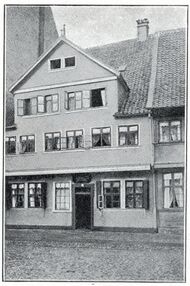
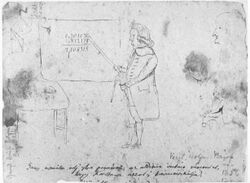
Johann Carl Friedrich Gauss was born on 30 April 1777 in Brunswick (Braunschweig), in the Duchy of Brunswick-Wolfenbüttel (now part of Lower Saxony, Germany), to a family of lower social status.[16] His father Gebhard Dietrich Gauss (1744–1808) worked in several jobs, as butcher, bricklayer, gardener, and as treasurer of a death-benefit fund. Gauss characterized his father as an honourable and respected man, but rough and dominating at home. He was experienced in writing and calculating, but his wife Dorothea (1743–1839), Carl Friedrich's mother, was nearly illiterate. Carl Friedrich was christened and confirmed in a church[lower-alpha 1] near the school that he attended as a child.[17] He had one elder brother from his father's first marriage.
Gauss was a child prodigy in the field of mathematics. When the elementary teachers noticed his intellectual abilities, they brought him to the attention of the Duke of Brunswick, who sent him to the local Collegium Carolinum,[lower-alpha 2] which he attended from 1792 to 1795 with Eberhard August Wilhelm von Zimmermann as one of his teachers. Thereafter the Duke granted him the resources for studies of mathematics, sciences, and classical languages at the Hanoverian University of Göttingen until 1798.[4] It is not known why Gauss went to Göttingen and not to the University of Helmstedt near his native Brunswick, but it is assumed that the large library of Göttingen, where students were allowed to borrow books and take them home, was the decisive reason.[18] One of his professors in mathematics was Abraham Gotthelf Kästner, whom Gauss called "the leading mathematician among poets, and the leading poet among mathematicians" because of his epigrams.[19] Gauss depicted him in a drawing showing a lecture scene where he produced errors in a simple calculation. Astronomy was taught by Karl Felix von Seyffer (1762–1822), with whom Gauss stayed in correspondence after graduation; Olbers and Gauss mocked him in their correspondence. On the other hand, he thought highly of Georg Christoph Lichtenberg, his teacher of physics, and of Christian Gottlob Heyne, whose lectures in classics Gauss attended with pleasure.[20] Fellow students of this time were Johann Friedrich Benzenberg, Farkas Bolyai, and Heinrich Wilhelm Brandes.
Though being a registered student at university, it is evident that he was a self-taught student in mathematics, since he independently rediscovered several theorems.[21] He succeeded with a breakthrough in a geometrical problem that had occupied mathematicians since the days of the Ancient Greece when he determined in 1796 which regular polygons can be constructed by compass and straightedge. This discovery was the subject of his first publication and ultimately led Gauss to choose mathematics instead of philology as a career.[22] Gauss' mathematical diary shows that, in the same year, he was also productive in number theory. He made advanced discoveries in modular arithmetic, found the first proof of the quadratic reciprocity law, and dealt with the prime number theorem. Many ideas for his mathematical magnum opus Disquisitiones arithmeticae, published in 1801, date from this time.
Private scholar
Gauss graduated as a Doctor of Philosophy in 1799. He did not graduate from Göttingen, as is sometimes stated,[lower-alpha 3][23] but rather, at the Duke of Brunswick's special request, from the University of Helmstedt, the only state university of the duchy. There, Johann Friedrich Pfaff assessed his doctoral thesis, and Gauss got the degree in absentia without the further oral examination that was usually requested. The Duke then granted him his cost of living as a private scholar in Brunswick. Gauss showed his gratitude and loyalty for this bequest when he refused several calls from the Russian Academy of Sciences in St. Peterburg and from Landshut University. Later, the Duke promised him the foundation of an observatory in Brunswick in 1804. Architect Peter Joseph Krahe made preliminary designs, but one of Napoleon's wars cancelled those plans:[24] the Duke was mortally wounded in the battle of Jena in 1806. The duchy was abolished in the following year, and Gauss's financial support stopped. He then followed a call to the University of Göttingen, an institution of the newly founded Kingdom of Westphalia under Jérôme Bonaparte, as full professor and director of the astronomical observatory.
Studying the calculation of asteroid orbits, Gauss established contact with the astronomical community of Bremen and Lilienthal, especially Wilhelm Olbers, Karl Ludwig Harding and Friedrich Wilhelm Bessel, as part of the informal group of astronomers known as the Celestial police.[25] One of their aims was the discovery of further planets, and they assembled data on asteroids and comets as a basis for Gauss's research. Gauss was thereby able to develop new, powerful methods for the determination of orbits, which he later published in his astronomical magnum opus Theoria motus corporum coelestium (1809).
Professor in Göttingen

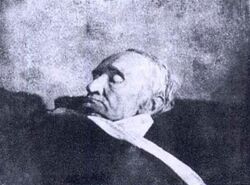
Gauss arrived at Göttingen in November 1807, and in the following years he was confronted with the demand for two thousand francs from the Westphalian government as a war contribution. Without having yet received his salary, he could not raise this enormous amount. Both Olbers and Laplace wanted to help him with the payment, but Gauss refused their assistance. Finally, an anonymous person from Frankfurt, later discovered to be Prince-primate Dalberg,[26] paid the sum.
Gauss took on the directorate of the 60-year-old observatory, founded in 1748 by Prince-elector George II and built on a converted fortification tower,[27] with usable, but partly out-of-date instruments.[28] The construction of a new observatory had been approved by Prince-elector George III in principle since 1802, and the Westphalian government continued the planning,[29] but the building was not finished until October 1816. It contained new up-to-date instruments, for instance two meridian circles from Repsold[30] and Reichenbach,[31] and a heliometer from Fraunhofer.[32]
The scientific activity of Gauss, besides pure mathematics, can be roughly divided into three periods: in the first two decades of the 19th century astronomy was the main focus, in the third decade geodesy, and in the fourth decade he occupied himself with physics, mainly magnetism.[33]
Gauss remained mentally active into his old age, even while suffering from gout and general unhappiness. His last observation was the solar eclipse of July 28, 1851.[34] On 23 February 1855, Gauss died of a heart attack in Göttingen;[19] he is interred in the Albani Cemetery there. Heinrich Ewald, Gauss's son-in-law, and Wolfgang Sartorius von Waltershausen, Gauss's close friend and biographer, gave eulogies at his funeral.
Gauss's brain
The day after Gauss's death his brain was removed, preserved and studied by Rudolf Wagner, who found its mass to be slightly above average, at 1,492 grams (52.6 oz).[35][36] The cerebral area was determined by Wagner's son Hermann in his doctoral thesis to be 219,588 square millimetres (340.362 sq in).[37] Highly developed convolutions were also found, which in the early 20th century were suggested as the explanation for his genius.[38] After various previous investigations, a magnetic resonance study of 1998, done at the Max Planck Institute for Biophysical Chemistry in Göttingen, gave no results which could be used to explain his mathematical abilities.[39]
In 2013, a neurobiologist at the same institute discovered that Gauss's brain had been mixed up, due to mislabelling, with that of the physician Conrad Heinrich Fuchs, who died in Göttingen a few months after Gauss.[40] A further investigation showed no remarkable anomalies in the brains of either person. Thus, all investigations on Gauss's brain until 1998, except the first ones of Rudolf and Hermann Wagner, actually refer to the brain of Fuchs.[41]
Family
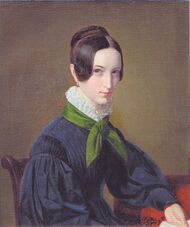
Gauss married Johanna Osthoff (1780–1809) on 9 October 1805.[42] They had two sons and a daughter: Joseph (1806–1873), Wilhelmina (1808–1840) and Louis (1809–1810). Johanna died on 11 October 1809 one month after the birth of Louis, who himself died a few months later.
Gauss remarried within a year, on 4 August 1810, to Wilhelmine (Minna) Waldeck (1788–1831), a friend of his first wife. They had three more children: Eugen (later Eugene) (1811–1896), Wilhelm (later William) (1813–1879) and Therese Staufenau (de) (1816–1864). Minna Gauss died on 12 September 1831 after being seriously ill for more than a decade.[43] Therese then took over the household and cared for Gauss for the rest of his life; after her father's death she married the actor Constantin Staufenau.[44] Her sister Wilhelmina married the orientalist Heinrich Ewald.[45] Gauss' mother Dorothea lived in his house from 1817 until her death in 1839.[4]
The eldest son Joseph, whilst still a schoolboy, helped his father as an assistant during his survey campaign in summer 1821. After a short time at university, in 1824 Joseph joined the Hanoverian army and assisted in surveying again in 1829. In the 1830s he was responsible for the enlargement of the survey network to the western parts of the kingdom. With his geodetical qualifications he left the service and engaged in the construction of the railway network as director of the Royal Hanoverian State Railways. In 1836 he studied the railroad system in the US for some months.[46][lower-alpha 4]
Eugen left Göttingen in September 1830 and emigrated to the United States, where he joined the army for five years. He then worked for the American Fur Company in the Midwest, where he learned the Sioux language. Later, he moved to Missouri and became a successful businessman.[46] Wilhelm married a niece of the astronomer Friedrich Bessel and also moved to Missouri in 1837,[49] starting as a farmer and later becoming wealthy in the shoe business in St. Louis.[50] Eugene and William have numerous descendants in America, but the descendants left in Germany all derive from Joseph, as the Gauss daughters had no children.[46]
Personality
The scholar
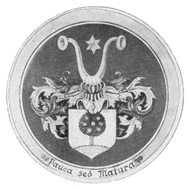
At the end of the 18th century, German academic mathematics was in a poor condition: the prolific mathematicians of that time worked in France and other European countries.[lower-alpha 5] The mathematical mainstream mainly dealt with solving practical problems in mechanics, astronomy, geodesy, etc.[52] In this scientific environment, Gauss can be seen, following Felix Klein, as typical of both 18th and 19th-century mathematicians. His interest in practical applicability, for example in geodesy and astronomy, qualified Gauss to be taken as a typical applied mathematician of the century of enlightenment. On the other hand, he began research in numerous parts of mathematics without defined links to practical purposes, and thus showed himself as a pioneer of what was later called "pure mathematics". In contrast to earlier mathematicians, such as Leonhard Euler—who let their readers take part in their reasoning as they developed new ideas, and included certain erroneous deviations from the correct path—Gauss developed a new style of direct and complete explanation that did not attempt to show the reader the author's train of thought.[53][54]
- "Gauss was the first to restore that rigor of demonstration which we admire in the ancients and which had been forced unduly into the background by the exclusive interest of preceding period in new developments."[55]
But for himself, he propagated a quite different ideal, given in a letter to Farkas Bolyai on 2 September 1808 as follows:[56]
It is not knowledge, but the act of learning, not possession but the act of getting there, which grants the greatest enjoyment. When I have clarified and exhausted a subject, then I turn away from it, in order to go into darkness again.
— Dunnington 2004, p. 416
Gauss refused to publish work which he did not consider complete and above criticism. This perfectionism was in keeping with the motto of his personal seal Pauca sed Matura ("Few, but Ripe"). His personal diary indicates that he had made several mathematical discoveries years or decades before contemporaries published them. He put down new ideas in writing to his colleagues, who encouraged him to publish, and sometimes rebuked him if he hesitated too long, in their opinion. Gauss defended himself, claiming that the initial discovery of ideas was easy, but preparing a publishable elaboration was a demanding matter for him, for either lack of time or "serenity of mind".[57] Nevertheless, he published many short communications of urgent content in various journals, but his "Collected Works" contain a considerable literary estate, too.[58][59] Eric Temple Bell said that if Gauss had published all of his discoveries in a timely manner, he would have advanced mathematics by fifty years.[60]
On certain occasions, Gauss claimed that a finding published by another scholar had already been in his possession previously. Thus his concept of priority as "the first to discover, not the first to publish" differed from that of his scientific contemporaries.[61] In contrast to his perfectionism in presenting mathematical ideas, he was criticized for his negligent way of quoting. He justified himself with a very special view of correct quoting: if he gave references, then only in a quite complete way, with respect to the previous authors of importance, which no one should ignore; but quoting in this way needed knowledge of the history of science and more time than he wished to spend.[57]
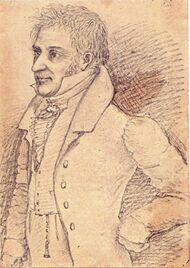
Though Gauss is seen as a master of axiomatic presentation, it became obvious from his posthumously published papers, his diary, and short glosses in his own textbooks, that he worked to a great extent in an empirical way. Gauss was a lifelong busy and enthusiastic calculator. He coped with the enormous workload by using skillful tools.[62] Gauss used a lot of mathematical tables, examined their qualities[clarification needed], and constructed new tables on various matters for personal use.[63] He developed new tools for effective calculation, for example the Gaussian elimination. It has been taken as a curious feature of his working style that he carried out calculations with a high degree of precision, much more than required.[64] Very likely, this method gave him a lot of material which he used in finding theorems in number theory.[62]
It was well known to his close colleagues that Gauss disliked giving academic lectures. He first stated this to Olbers in 1802, so this aversion was not the result of bad experience. Thus he refused to accept any academic position with teaching duties during his years as a private scholar. But from the start of his academic career at Göttingen in 1807, he continuously gave lectures until 1854.[65] He often complained about the efforts of teaching, feeling that it was a waste of his time, but on the other hand he occasionally described one or other student as talented. In all these 47 years of teaching he gave only three lectures on subjects of pure mathematics, whereas most of his lectures dealt with astronomy, geodesy, and applied mathematics. However, many of Gauss' students went on to become renowned mathematicians, physicists, and astronomers: Moritz Cantor, Dedekind, Dirksen, Encke, Gould,[lower-alpha 6] Heine, Klinkerfues, Kupffer, Listing, Möbius, Nicolai, Riemann, Ritter, Schering, Scherk, Schumacher, Seeber, von Staudt, Stern, Ursin; as geoscientists Sartorius von Waltershausen and Wappäus.[67]
Gauss did not write any textbook, and (unlike his friends Bessel, Humboldt, and Olbers) he disliked the popularization of scientific matters. His only attempts at popularization were his works on the date of Easter[68] and the essay Erdmagnetismus und Magnetometer of 1836.[57]
Gauss published his papers and books exclusively in Latin or in German.[lower-alpha 7]
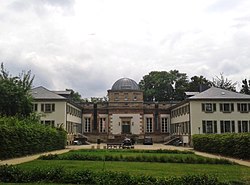
At Göttingen University, Gauss was accompanied by a staff of other lecturers in his disciplines, who completed the educational program: for instance the brilliant Thibaut in mathematics, in physics Weber and Mayer, well known for his successful textbooks, and Harding, who took the main part of lectures in astronomy. When the observatory was completed, Gauss took his living accommodation in the western wing of the new observatory and Harding in the eastern one. Once they had been on friendly terms with another, but in the course of time they became alienated, possibly – as some biographers presume – because Gauss had wished the equal-ranked Harding to be no more than his assistant or observer.[lower-alpha 8] The years since 1820 were evaluated as a "period of lower astronomical activity".[70] The new, well-equipped observatory did not work as effectively as others; Gauss' astronomical research had the character of a one-man enterprise, and the university established a place for an assistant only after Harding's death in 1834. But nevertheless Gauss twice refused the opportunity to solve the problem by accepting offers from Berlin in 1810 and 1825 to become a full member of the Prussian Academy, without no great lecturing duties, as well as from Leipzig University in 1810 and from Vienna University in 1842. Perhaps the reason was the difficult situation of his family.[71] In his later years, Gauss was one of the best-paid professors of the university.[46]
When Gauss was asked for help by his friend Friedrich Wilhelm Bessel in 1810, who was in trouble at Königsberg University because of his lack of an academic title,[lower-alpha 9] Gauss provided a doctorate honoris causa for Bessel from the Philosophy Faculty of Göttingen in March 1811. Gauss gave another recommendation for an honorary degree for Sophie Germain, but only shortly before her death, so she never received it.[72] He also gave successful support for the talented mathematician Gotthold Eisenstein in Berlin.
After King William IV's death in 1837, the personal union between the kingdoms of Great Britain and Ireland and Hanover ceased. In the same year, the new Hanoverian King Ernest Augustus annulled the constitution given to the state by his brother in 1833. Seven prominent professors, later known as the "Göttingen Seven", protested against this, among them Gauss' friend and collaborator Wilhelm Weber and Gauss' son-in-law Heinrich Ewald. All of them were dismissed, three of them were expelled, but Ewald and Weber could stay in Göttingen. Ewald took a position the University of Tübingen in 1838, where Gauss' daughter Wilhelmina died soon afterwards in 1840, and with Weber went to Leipzig in 1843; but both of them returned to their Göttingen positions in 1849 as the only ones of the Göttingen Seven. Gauss was deeply affected by this quarrel, but saw no possibility to help them.[73]
Gauss took part in academic administration: three times he was elected as dean of the Philosophy Faculty.[74] Being entrusted with the widow's pension fund of the university, he dealt with actuarial science and wrote a report on the strategy for stabilizing the benefits. He was appointed director of the Royal Academy of Sciences in Göttingen for nine years, even in his last year of life.[74]
The private man
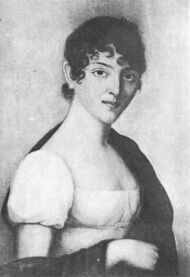
Soon after Gauss' death, his friend Sartorius published the first biography (1856), written in a rather enthusiastic style. Sartorius saw Gauss as a serene and forward-striving man with childlike modesty,[75] but also of "iron character"[76] with an unshakeable strength of mind.[77] He was noted for a sense of justice[78] and religious tolerance.[79] Apart from his closer circle, others regarded him as reserved and unapproachable, "like an Olympian sitting enthroned on the summit of science".[80] His close contemporaries agreed that Gauss was a man of difficult character. He often refused to accept compliments. His visitors were occasionally irritated by grumpy behaviour, but a short time later his mood could change, and he became a charming, open-minded host.[57]
Gauss' life was overshadowed by severe problems in his family. When his first wife Johanna suddenly died shortly after the death of their third child, he plunged into a depression from which he never fully recovered. Soon after her death he wrote a last letter to her in the style of an ancient threnody, the most personal surviving document of Gauss'.[81][82] The situation worsened when tuberculosis afflicted, and ultimately destroyed the health of, his second wife Minna over 13 years; both his daughters later suffered from the same disease.[83] Both younger sons were educated for some years in Celle far from Göttingen. Gauss himself gave only slight hints of his personal distress: in a letter to Bessel dated December 1831 he described himself as "the victim of the worst domestic sufferings".[57]
Gauss grew to dominate his children and eventually had conflicts with his sons, because he did not want any of them to enter mathematics or science for "fear of lowering the family name", as he believed none of them would surpass his own achievements. The military career of his elder son Joseph ended after more than two decades with the rank of a poorly paid first lieutenant, although he had acquired a considerable knowledge of geodesy. He needed financial support from his father even after he was married.[46] The second son Eugen shared a good measure of Gauss' talent in computation and languages, but had a vivacious and sometimes rebellious character. He wanted to study philology, whereas Gauss wanted him to become a lawyer. Having run up debts and caused a scandal in public,[84] he suddenly left Göttingen under dramatic circumstances in September 1830 and emigrated via Bremen to the United States. He wasted the little money he had taken for starting, after which his father refused further financial support. The youngest son Wilhelm wanted to qualify for agricultural administration, but had difficulties to get an appropriate education, and emigrated as well. Only Gauss' youngest daughter Therese accompanied him in his last years of life.
Collecting numerical data on very different things, useful or useless, became a habit in his later years, for example the number of paths from his home to certain places in Göttingen, or the numbers of living days of persons; he congratulated Humboldt in December 1851, when he had reached the same age as Isaac Newton at his death, calculated in days.[85]
Gauss had a good knowledge of Latin as well as of modern languages. At the age of 62, he began to teach himself Russian, very likely to understand scientific writings from Russia, among them those of Lobachevsky on non-Euclidean geometry.[86] Gauss read both classical and modern literature, the English and French in the original languages.[lower-alpha 10] His favorite English author was Walter Scott, his favorite German Jean Paul.[88] Gauss liked singing and went to concerts.[89] He was a busy newspaper reader, and in his last years he used to visit an academic press salon of the university every noon.[90] Gauss did not care much for philosophy, and mocked the "splitting hairs of the so-called metaphysicians", by which he meant proponents of the contemporary school of Naturphilosophie.[91]
Gauss' religious beliefs have been a subject of speculation by some of his biographers. He sometimes said: "God is calculating."[92] and: "I succeeded - not on account of my hard efforts, but by the grace of the Lord."[93] Gauss was a member of the Lutheran church, like most of the population in northern Germany, but it seems that he did not believe all dogmas or understand the Holy Bible to be true quite literally.[94] Sartorius mentioned Gauss' religious tolerance, and estimated his "insatiable thirst for truth" and his sense of justice as motivated by religious convictions.[79]
Gauss had an "aristocratic and through and through conservative nature", with little respect for people's intelligence and morals, in accordance with the motto "mundus vult decipi". As far as the political system is concerned, he had a low estimation of the constitutional system; he criticized parliamentarians of his time for a lack of knowledge and logical errors.[90] Gauss was loyal to the House of Hanover, disliked Napoleon and his system, and all kind of violence and revolution caused horror to him. Thus he condemned the methods of the Revolutions of 1848, though he agreed with some of their aims, such as the idea of a unified Germany.[76][lower-alpha 11]
Gauss was a successful investor and accumulated considerable wealth with stocks and securities, but he disapproved of the idea of paper money.[95] After his death a great sum of money was found hidden in his rooms.[96]
Scientific work
Algebra and number theory
Fundamental theorem of algebra
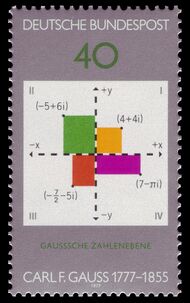
In his doctoral thesis from 1799 Gauss proved the fundamental theorem of algebra which states that every non-constant single-variable polynomial with complex coefficients has at least one complex root. Mathematicians including Jean le Rond d'Alembert had produced false proofs before him, and Gauss' dissertation contains a critique of d'Alembert's work. He subsequently produced three other proofs, the last one in 1849 being generally rigorous. His attempts clarified the concept of complex numbers considerably along the way.[97]
Disquisitiones Arithmeticae
The entries in Gauss' Mathematical diary indicate that he was busy with the subject of number theory at least since 1796. A detailed study of previous researches showed him that some of his findings had been already done by other scholars. In the years 1798 and 1799 Gauss wrote a voluminous compilation of all these results in the famous Disquisitiones Arithmeticae, published in 1801, that was fundamental in consolidating number theory as a discipline and covered both elementary and algebraic number theory. Therein he introduces, among other things, the triple bar symbol (≡) for congruence and uses it in a clean presentation of modular arithmetic. It deals with the unique factorization theorem and primitive roots modulo n. In the main chapters, Gauss presents the first two proofs of the law of quadratic reciprocity, which allows mathematicians to determine the solvability of any quadratic equation in modular arithmetic, and develops the theories of binary and ternary quadratic forms.
Highlights of these theories include the remarkable Gauss composition law for binary quadratic forms, as well as his enumeration of the number of representations of an integer as sum of three squares. As an almost immediate corollary of his theorem on three squares, he proves the triangular case of the Fermat polygonal number theorem for n = 3. From several remarkable analytic results on class numbers that Gauss gives without proof towards the end of the fifth chapter, it appears that Gauss already knew the class number formula in 1801.[98]
In the last chapter Gauss gives his proof for the constructibility of a regular heptadecagon (17-sided polygon) with straightedge and compass by reducing this geometrical to an algebraic problem. He shows that a regular polygon is constructible if the number of its sides is a product of distinct Fermat primes and a power of 2. In the same chapter, he gives a result on the number of solutions of certain cubic polynomials with coefficients in finite fields, which amounts to counting integral points on an elliptic curve. Some 150 years later, Andre Weil remarked that this particular result, together with some other unpublished results of Gauss, led him to formulate what is now called Weil conjectures.[99][lower-alpha 12]
Gauss intended to include an eighth chapter that would treat the topic of higher congruences modulo a prime number in its full generality, but the unfinished chapter was found among his papers only after his death, consisting of work done during the years 1797–1799.
Further investigations
In 1831, Ludwig August Seeber published a book on the theory of reduction of positive ternary quadratic forms,[101] with accordance with the program outlined in Gauss's Disquisitiones. However, he did not prove a central theorem of his theory, so it remained a mere conjecture. In his review of Seeber's book, Gauss simplified many of Seeber's lengthy arguments, proved this central conjecture, and remarked that this theorem is equivalent to Kepler conjecture for regular arrangements.[102]
Gauss proved Fermat's Last Theorem for n = 3 and sketchingly proved it for n = 5 in his unpublished writings. The particular case of n = 3 was proved much earlier by Leonhard Euler, but Gauss developed a more streamlined proof which made use of Eisenstein integers; though more general, the proof was simpler than in the real integers case.
Among his published number theoretical works, his two papers on biquadratic residues (published in 1828 and 1832) are considered second in importance only to Disquisitions Arithmeticae. In these papers Gauss introduces the ring of Gaussian integers , and shows that this ring is a unique factorization domain. Furthermore, he generalizes into this ring many key arithmetic concepts, such as Fermat's little theorem and Gauss's lemma. The main objective of introducing this ring was to formulate the law of biquadratic reciprocity – as Gauss discovered, rings of complex integers are the natural setting for such higher reciprocity laws.
In the second paper, he states the general law of biquadratic reciprocity and proves several special cases of it, but proof of the general theorem is lacking, despite Gauss's statements that he found such a proof around 1814. He promised a third paper with a general proof, but this never appeared. In an earlier publication from 1818 containing his fifth and sixth proofs of quadratic reciprocity, he claims the techniques of these proofs (Gauss sums) can be applied to prove higher reciprocity laws.
Gauss's publications on biquadratic residues opened the way for boundless enlargement of the theory of numbers, and are memorable for the wealth of investigations in "higher arithmetic" that they led to.
Analysis
One of Gauss's first independent discoveries was the notion of the arithmetic-geometric mean (AGM) of two positive real numbers; his systematic investigations on the AGM led him to discover an unusually rich mathematical landscape, and to obtain plenty of new results associated with it. He discovered its relation to elliptic integrals in the years 1798-1799 through the so-called Landen's transformation, and in a diary entry recorded his discovery of the connection of Gauss's constant to lemniscatic elliptic functions, a result that Gauss stated that "will surely open a new area of analysis". He also made early inroads into the more formal issues of the foundations of complex analysis, and from a letter to Bessel in 1811 it is clear that he knew the so-called "fundamental theorem of complex analysis" - Cauchy's integral theorem - and understood the notion of complex residues when integrating around poles.
Another source of inspiration for Gauss's early work in analysis was his acquaintance with Euler's pentagonal numbers theorem. This theorem together with his other researches on the AGM and lemniscatic functions led him to plenty of results on Jacobi theta functions, work which culminated with his discovery in 1808 of the later called Jacobi triple product identity, which includes Euler's theorem as a special case.[103] In his publication from 1811 on the determination of the sign of quadratic Gauss sum, Gauss solved the problem by introducing Gaussian binomial coefficients and by using a line of reasoning that somehow "hides" its origin in theta function theory, as later mathematicians have shown. All this work was done several decades before the publication of Jacobi's "Fundamenta nova" in 1829; however, Gauss never found the time to systematically write and organize all his thoughts and theorems of this kind, and his contemporaries never knew the scope of his work.
Several mathematical fragments in his Nachlass indicate that he knew quite well parts of the modern theory of modular forms of Felix Klein and Robert Fricke. In his work on the multivalued AGM of two complex numbers, he discovered a very deep connection between the infinitely many values of the AGM to its two "simplest values".[104] His unpublished writings include several drawings that show he was quite aware of the geometric side of the theory; in the context of his work on the complex AGM he recognized and made a sketch of the key concept of fundamental domain for the modular group.[lower-alpha 13] One of Gauss's sketches of this kind was his drawing of a tessellation of the unit disk by "equilateral" hyperbolic triangles with all angles equal to .
In his lifetime Gauss published almost nothing about those more modern theories of elliptic functions, but he did publish most of his results on the related theme of the hypergeometric function. In his work "Disquisitiones generales circa series infinitam..." (1812), he provided the first systematic treatment of the general hypergeometric function , and showed that many of the functions known to science at the time, such as the elementary functions and some special functions, are a special case of the hypergeometric function.[105] This work was the first one with an exact inquiry of convergence of infinite series in the history of mathematics.[106] Furthermore, it dealt with infinite continued fractions arising as ratios of hypergeometric functions.
In 1822 Gauss published his prize winning essay on conformal mappings, which contains several developments that pertain to the field of complex analysis. In this essay, Gauss made explicit the insight that angle-preserving mappings in the complex plane must be complex analytic functions, and used the so-called Beltrami equation to prove the existence of isothermal coordinates on analytic surfaces. The essay concludes with examples of conformal mappings into a sphere and an ellipsoid of revolution. In addition, in unpublished fragments from the years 1834-1839 he investigated and solved the more difficult task of explicitly constructing a conformal mapping from the interior of an ellipse to the unit disk.[107] His solution, which combined his early work on elliptic functions and his later ideas on potential theory, reveals his mastery of the theory of logarithmic potential, and his final results corresponded to the formula found by Hermann Schwarz in 1870.
Numeric analysis
Gauss often deduced theorems inductively from numerical data he had collected in an empirical way. As such, the use of efficient algorithms to facilitate calculations was vital to his researches, and he made many contributions to numeric analysis. In 1815, he published an article on numeric integration, in which he described his method of Gaussian quadrature, that greatly improved existing methods and inspired much of the work made by later mathematicians.
In a private letter to Gerling from 1823,[108] he described a solution of a certain 4X4 system of linear equations by using Gauss-Seidel method – an "indirect" iterative method for the solution of linear systems, that in some cases converges very rapidly to the exact solution. Gauss recommended it over the usual method (the so-called "direct elimination") for systems of more than 2 equations, stating that it can be done "while half asleep, or while thinking about other things".[109] As such, it was an early contribution to numerical linear algebra.
Gauss invented an algorithm for calculating what are now called discrete Fourier transforms, sometimes called "the most important numerical algorithm of our lifetime", when calculating the orbits of Pallas and Juno in 1805, 160 years before Cooley and Tukey published their similar Cooley–Tukey FFT algorithm.[110] He developed it as a trigonometric interpolation method, but his paper Theoria Interpolationis Methodo Nova Tractata was published only posthumously in 1866,[111] preceded by the first presentation by Joseph Fourier on the subject in 1807.[112]
Chronology
The first publication following the doctoral thesis dealt with the determination of the date of Easter (1800), a very elementary matter of mathematics. Gauss aimed to present a most convenient algorithm for people without any knowledge in ecclesiastical or even astronomical chronology, and thus avoided the usually required terms of golden number, epact, solar cycle, and domenical letter, and any religious connotations.[113] Biographers speculated on the reason why Gauss dealt with this matter, but it is likely comprehensible by the historical background. The replacement of the Julian calendar by the Gregorian calendar had caused great confusion to the hundreds of states of the Holy Roman Empire since the 16th century, and was finished in Germany not until the year 1700, when the difference of eleven days was deleted, but the difference in calculating the date of Easter remained between Protestant and Catholic territories. A further agreement of 1776 equalized the confessional way of counting, thus in the Protestant states like the Duchy of Brunswick the Easter of 1777, five weeks before Gauss' birth, was the first one calculated in the new manner.[114] The public difficulties of replacement may be the historical background for the confusion on this matter in the Gauss family (see chapter: Anecdotes). For being connected with the Easter regulations, an essay on the date of Pesach followed soon in 1802.
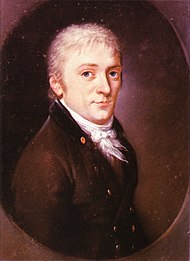
Astronomy
On 1 January 1801, Italian astronomer Giuseppe Piazzi discovered the dwarf planet Ceres.[115] Piazzi could track Ceres for only somewhat more than a month, following it for three degrees across the night sky, less than 1% of the total orbit, until it disappeared temporarily behind the glare of the Sun. Several months later, when Ceres should have reappeared, Piazzi could not locate it: the mathematical tools of the time were not able to extrapolate a position from such a scant amount of data. Gauss tackled the problem within three months of intense work, and predicted a position for Ceres in December 1801. This turned out to be accurate within a half-degree when it was rediscovered by Franz Xaver von Zach on 7/31 December at Gotha, and independently by Heinrich Olbers on 1/2 January in Bremen.[116][lower-alpha 14] This confirmation eventually led to the classification of Ceres as minor-planet designation 1 Ceres; that was taken as the predicted planet between Mars and Jupiter by the most speculative Titius–Bode law.[23]
Gauss's method involved determining a conic section in space, given one focus (the Sun) and the conic's intersection with three given lines (lines of sight from the Earth, which is itself moving on an ellipse, to the planet) and given the time it takes the planet to traverse the arcs determined by these lines (from which the lengths of the arcs can be calculated by Kepler's Second Law). This problem leads to an equation of the eighth degree, of which one solution, the Earth's orbit, is known. The solution sought is then separated from the remaining six based on physical conditions. In this work, Gauss used comprehensive approximation methods which he created for that purpose.[117] Zach noted that "without the intelligent work and calculations of Doctor Gauss we might not have found Ceres again".
The discovery of Ceres led Gauss to his work on a theory of the motion of planetoids disturbed by large planets, eventually published in 1809 as Theoria motus corporum coelestium in sectionibus conicis solem ambientum. In the process, he so streamlined the cumbersome mathematics of 18th-century orbital prediction that his work remains a cornerstone of astronomical computation.[118] It introduced the Gaussian gravitational constant.
Since the new asteroids had been discovered, Gauss occupied himself with the perturbations of their orbital elements. Firstly he examined Ceres with analytical methods similar to those of Laplace, but his favorite object was Pallas, because of its great eccentricity and orbital inclination, whereby Laplace's method did not work. Gauss used his own tools : the arithmetic–geometric mean, the hypergeometric function, and his method of interpolation.[119] He found an orbital resonance with Jupiter in proportion 18 : 7 in 1812; Gauss published this result as cipher, and gave the explicit meaning only in letters to Olbers and Bessel.[120][121][lower-alpha 15] However, after long years he finished his work in 1816 without a result that seemed sufficient to him. This marked the end of his activities in theoretical astronomy, too.[123]
One fruit of Gauss's research on Pallas perturbations was his article Determinatio Attractionis... (1818) on a method of theoretical astronomy that later became known as the "elliptic ring method". This method introduced a useful averaging conception in which a planet in orbit is replaced by a fictitious ring with mass density proportional to the time taking the planet to follow the corresponding orbital arcs.[124] Gauss presents his method of evaluating the gravitational attraction of such an elliptic ring, which includes several complicated steps; one such step involves a direct application of the arithmetic-geometric mean (AGM) algorithm to calculate an elliptic integral.[lower-alpha 16] In the late 19th century Gauss's method was adapted by American astronomer George William Hill, who applied it directly to the problem of secular perturbation induced by Venus on Mercury orbit.[125]
Theory of errors
It is likely that Gauss used the method of least squares for calculating the orbit of Ceres to minimize the impact of measurement error.[8] The method was published first by Adrien-Marie Legendre in 1805, but Gauss claimed in Theoria motus (1809) that he had been using it since 1794 or 1795.[7] In the history of statistics, this disagreement is called the "priority dispute over the discovery of the method of least squares".[61] Gauss proved the method under the assumption of normally distributed errors (Gauss–Markov theorem) in his paper Theoria combinationis observationum erroribus minimis obnoxiae from 1821.
In this paper, which was relatively little known in the English speaking world in the first century after its publication, he stated and proved Gauss's inequality (a Chebyshev-type inequality) for unimodal distributions, and stated without proof another inequality for moments of the fourth order (a special case of Gauss-Winckler inequality).[126] He derived lower and upper bounds for the variance of sample variance.[lower-alpha 17] In a supplement to this paper Gauss described recursive least squares methods that went unnoticed until 1950, when his work was rediscovered as a consequence of the growing demand of quick estimation for various new technologies. Gauss's work on the theory of errors was extended in several directions by the geodesist Friedrich Robert Helmert, and the Gauss-Helmert theory is considered today as the "classical" theory of errors.
Gauss made several striking contributions to problems in probability theory that are not directly concerned with the theory of errors, but offer a glimpse into his broad minded view on the applicability of probabilistic thinking. One remarkable example appears as a note in his diary and is concerned with a very unusual problem that came to his mind: to describe the asymptotic distribution of entries in the continued fraction expansion of a random number uniformly distributed in (0,1). He derived this distribution, now known as the Gauss-Kuzmin distribution, as a by-product of his discovery of the ergodicity of the Gauss map for continued fractions. Gauss's solution is the first ever result in the metrical theory of continued fractions.
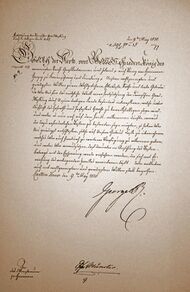
Arc measurement and geodetic survey
Gauss was busy with geodetic problems since 1799, when he helped Karl Ludwig von Lecoq with calculations during his survey in Westphalia.[127] Later since 1804, he taught himself some geodetic practise with a sextant in Brunswick,[128] and Göttingen.[129]
Since 1816, his former student Heinrich Christian Schumacher, then professor in Copenhagen, but living in Altona (Holstein) near Hamburg, made a triangulation of the Jutland peninsula from Skagen in the north to Lauenburg in the south.[lower-alpha 18] The aim was not only the foundation of map production, but also the determination of the geodetic arc of that distance. Schumacher asked Gauss to continue this work further to the south and said he could find support for this project directly from the government of Hanover. Finally in May 1820, King George IV gave the order to Gauss.[130]
Gauss and Schumacher had yet determined some angles between Lüneburg, Hamburg, and Lauenburg for the geodetic connection in October 1818.[131] During the summers of 1821 until 1825 Gauss directed the triangulation personally, that reached from Thuringia in the south to the river Elbe in the north. The triangel between Hoher Hagen, Großer Inselsberg in the Thuringian Forest, and Brocken in the Harz mountains was the largest one Gauss had ever measured with a maximum side of 107 km (66.5 miles). In the thin populated Lüneburg Heath, without significant natural summits or artificial buildings, he had great difficulties to find suitable triangulation points, sometimes cutting lanes through the vegetation was necessary or even the erection of signal towers.[132]
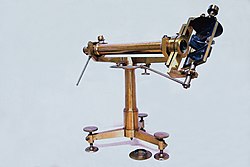

For pointing signals, Gauss invented a new instrument with movable mirrors and a small telescope that reflects the sunbeams to the triangulation points, and named it heliotrope. Another suitable construction for the same purpose was a sextant with an additional mirror which he named vice heliotrope.[133] Gauss got assistance by soldiers of the Hanoveran army, among them his eldest son Joseph. Gauss took part in the baseline measurement (Braak Base Line) of Schumacher in the village Braak near Hamburg in 1820, and used the result for the evaluation of his triangulation.[134]
The arc measurement needed a precise astronomical determination of two points in the network. Gauss and Schumacher used the favourite occasion that both observatories in Göttingen and in Altona, in the garden of Schumacher's house, laid nearly in the same longitude. The latitude was measured with both their own instruments and a zenith sector of Ramsden that was transported to both observatories.[135][lower-alpha 19]
An additional result was a better value of flattening of the approximative earth ellipsoid.[136][lower-alpha 20] Gauss developed the universal transverse Mercator projection of the ellipsoidal shaped earth (what he named conform projection)[138] for representing geodetical data in plane charts.
When the arc measurement was finished, Gauss intended the enlargement of the triangulation to the west to get a survey of the whole Kingdom of Hanover. The practical work was directed by three army officers, among them Lieutenant Joseph Gauss. The complete data evaluation laid in the hands of Carl Friedrich Gauss, who applied his mathematical inventions as the method of least squares and his elimination method to it. The project was finished in 1844, but Gauss did not publish a final report of the project and his method of projection; this work was not done until 1866.[139][140]
In 1828, when studying differences in latitude, Gauss first defined a physical approximation for the figure of the Earth as the surface everywhere perpendicular to the direction of gravity;[141] later his doctoral student Johann Benedict Listing called this the geoid.[142]
Differential geometry
The geodetic survey of Hanover fueled Gauss' interest in differential geometry and topology, fields of mathematics dealing with curves and surfaces. This led him in 1828 to the publication of a memoir that marks the birth of modern differential geometry of surfaces, as it departed from the traditional ways of treating surfaces as cartesian graphs of functions of two variables, and instead pioneered a revolutionary approach that initiated the exploration of surfaces from the "inner" point of view of a two-dimensional being constrained to move on it. Its crowning result, the Theorema Egregium (remarkable theorem), established a property of the notion of Gaussian curvature. Informally, the theorem says that the curvature of a surface can be determined entirely by measuring angles and distances on the surface. That is, curvature does not depend on how the surface might be embedded in 3-dimensional space or 2-dimensional space.
The Theorema Egregium leads to the abstraction of surfaces as doubly-extended manifolds - it makes clear the distinction between the intrinsic properties of the manifold (the metric) and its physical realization (the embedding) in ambient space. A consequence is the impossibility of an isometric transformation between surfaces of different Gaussian curvature. This means practically that a sphere or an ellipsoid cannot be transformed to a plane without distortion, what causes a fundamental problem in designing projections for geographical maps.
An additional significant portion of his essay is dedicated to a profound study of geodesics. In particular, Gauss proves the local Gauss-Bonnet theorem on geodesic triangles, and generalizes Legendre's theorem on spherical triangles to geodesic triangles on arbitrary surfaces with continuous curvature; he found that the angles of a "sufficiently small" geodesic triangle deviate from that of a planar triangle of the same sides in a way that depends only on the values of the surface curvature at the vertices of the triangle - regardless of the behaviour of the surface in the triangle interior.
One key differential geometric conception was lacking from Gauss's memoir, that of geodesic curvature. However, his posthumous papers show that this notion did not escape his mind, and in the years of composing his memoir he also wrote up a manuscript in which he introduced it and referred to it as "side curvature" (in German: "Seitenkrümmung"). More importantly, he proved its invariance under isometric transformations, a result later obtained by Ferdinand Minding. Based on this evidence and the announcement in his memoir of further investigations on the curvature integral, it is very likely that he knew the more general version of the Gauss-Bonnet theorem proved by Pierre Ossian Bonnet in 1848, which is closer in spirit to the global version of this theorem.[143][lower-alpha 21]
Non-Euclidean geometries
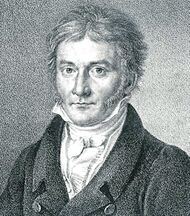
In the lifetime of Gauss a vivid discussion on Euclid‘s parallel axiom was going on. Numerous mathematicians made efforts to prove it, whereas some of them discussed the possibility of geometrical systems without it.[144] Gauss himself was only interested in the geometrical aspects of the physical space, but did not care about the philosophical aspects of an enlarged geometry. In 1816, he gave his first short public comment on this matter in a book review, and in the follwing time he occasionally made some remarks in letters to his correspondents.[145] He is the one who coined the term "non-Euclidean geometry".[11]
Not until Lobachevsky (1829) and Janos Bolyai (1832) had published their ideas of a non-Euclidean geometry – for the first time in history of mathematics – ,[144] Gauss himself put down his ideas, but avoided any influence to the contemporary scientific discussion, because he did not publish about it.[145] Gauss commended the ideas of Janos Bolyai in a letter to his father,[146] claiming that these were congruent to his own thoughts since some decades.[145][147] But it is not clear to what extent he preceded Lobachevsky and Bolyai, for he gave only vague and obscure remarks on it in his letters.[144]
Sartorius mentioned it first in 1856, but only the edition of left papers in Volume VIII of his Collected Works (1900) showed Gauss's own progress on that matter, at a time when Non-Euclidean geometry had yet grown out of controversial discussion.[145]
In 1854, Gauss selected the topic for Bernhard Riemann's inaugural lecture Über die Hypothesen, welche der Geometrie zu Grunde liegen from three proposals.[148][149] On the way home from Riemann's lecture, Weber reported that Gauss was full of praise and excitement.[150]
Early topology
One of the lesser known aspects of Gauss's work is that he was also an early pioneer of topology, or as it was called in his lifetime, Geometria Situs. His first proof of the fundamental theorem of the algebra contained an essentially topological argument; fifty years later, he further developed the topological argument in his fourth proof of this theorem (in 1849).
His earliest "serious" encounter with topological notions occurred to him in the course of his astronomical work, and in a small article from 1804 he determined the limits of the region on the celestial sphere in which comets and asteroids might appear, region which he termed "Zodiacus". He determined this region, and observed that if the Earth's and comet's orbits are linked, then by topological reasons the Zodiacus is the entire sphere. In 1848, in the context of the discovery of the asteroid 7 Iris, he published another short article in which he further elaborated the qualitative discussion of the Zodiacus.[151]
From Gauss's letters during the period of 1820–1830, one can learn that he thought intensively on topics with close affinity to Geometria Situs, and became gradually conscious of semantic difficulty in this field. Fragments from this period reveal that he tried to classify "Tractfigurens", which are closed plane curves with a finite number of transverse self-intersections, that may also be planar projections of knots. To do so he devised a symbolical scheme, the so-called Gauss code, that in a sense captured the characteristic features of tract figures.
In a fragment from 1833, Gauss defined the linking number of two space curves by a certain double integral, and in doing so provided for the first time an analytical formulation of a topological phenomenon. In the same note, he lamented on the little progress made in Geometria Situs, and remarked that one of its central problems will be "to count the intertwinings of two closed or infinite curves". His notebooks from that period reveal that he was also thinking about other topological objects such as braids and tangles.[151]
In his later years Gauss held the emerging field of topology in a very high esteem and expected great future developments for it, but since there is so few written material by Gauss from this period, his influence was made mainly through occasional remarks and oral communications.[lower-alpha 22] For example, an indirect report by Mobius referred to a surface constructed by Gauss, which Gauss called "double ring" and sayed something about its connectivity properties.[152] This report is consistent with a fragment of Gauss, written around 1840, which sketched a theory of the order of connectivity of surfaces.[153] Finally, it is worth mentioning that in the introduction to Listing's book "Vorstudien zur Topologie" (1847), Listing expressed his indebtness to Gauss's influence.
Minor mathematical accomplishments
Gauss's work did not only initiate significant mathematical theories, as he was also the author of many little "gems" in mathematics, especially in elementary geometry and algebra. In his way, he helped spread the new mathematical ideas of his time by demonstrating how they illuminate and shorten the solution of small mathematical problems.
For example, he was a vivid spirit in applying complex numbers to various problems, and used them in his work on perspective and projective geometry: in a short 1836 note on "Projections of the Cube", he stated the fundamental theorem of axonometry, which tells how to represent a 3D cube on a 2D plane with complete accuracy, via complex numbers.[154] In an unpublished 1819 note entitled "the Sphere", he conceived of the complex plane extended by a point at infinity as the stereographic projection of a sphere (the Riemann sphere), and described rotations of this sphere as the action of certain linear fractional transformations on the extended complex plane.[155]
Under the context of Gauss's heading of extended algebraic systems, it must be mentioned that there is solid evidence that he had in his foresight the algebraic system of quaternions, the discovery of the great William Rowan Hamilton. In 1819, Gauss drafted an unpublished short treatise on "Rotations of Space", in which he elaborated on the use of quadruples of real numbers (of which he called "scales") to describe 3D rotations.[156]
In elementary geometry, he contributed his solution to the problem of constructing the largest-area ellipse that can be inscribed in a given quadrilateral, which was published in 1810 as an addition to Schumacher's translation of Lazare Carnot's treatise Géométrie de position.[157] He discovered a surprising result about the computation of area of pentagons. He made many contributions to spherical geometry, and in this context solved some practical problems about navigation by stars.[lower-alpha 23]
One of his most remarkable investigations was concerned with John Napier's "Pentagramma mirificum" - a certain spherical pentagram whose properties intrigued and occupied Gauss's mind for several decades. In his studies of the Pentagramma he approached it from various points of view, and gradually gained a full understanding of its geometric, algebraic and analytic aspects. In particular, in 1843 he stated and proved several theorems connecting elliptic functions, Napier spherical pentagons and Poncelet pentagons in the plane.[158]
Magnetism and telegraphy
Geomagnetism
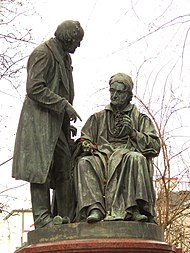
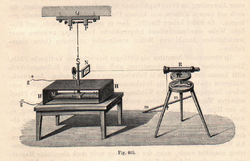
Gauss' interest in magnetism is obvious since the first decennium of the 19th century. Since 1826, when Alexander von Humboldt visited him in Göttingen, both scientists began intensive research on geomagnetism, partly independent, partly in productive cooperation.[159] In 1828, Gauss was Humboldt's personal guest during the conference of the Society of German Natural Scientists and Physicians in Berlin, where he got acquaintance with the physicist Wilhelm Weber.[160]
When Weber got the chair for physics in Göttingen as successor of Johann Tobias Mayer by Gauss' recommendation in 1831, both of them started a fruitful collaboration, leading to a new knowledge of magnetism with a representation for the unit of magnetism in terms of mass, charge, and time.[161] They founded the Magnetic Association (German: "Magnetischer Verein"), an international working group of several observatories, which supported measurements of Earth's magnetic field in many regions of the world with equal methods at arranged dates in the years 1836 to 1841. In 1836, Humboldt was helpful to organize the worldwide spread of observatories including the British dominions with a letter to the Duke of Sussex, then president of the Royal Society, wherein he asked for support for a program of global research based on Gauss' methods.[162] Together with other instigators, this led to a global programm known as "Magnetical crusade" under directory of Edward Sabine. The dates, times, and intervalls of observations were determined in advance, the Göttingen mean time was used as standard.[163] Finally 61 stations participated in this global program. Gauss and Weber founded a series for the publication of the results, six volumes were edited between 1837 and 1843. Weber's departure to Leipzig in 1843 as late effect of the Göttingen Seven affair marked the end of Magnetic Assiciation activity.[164]
Following Humboldt's example, Gauss ordered a magnetic observatory to be built in the garden of his observatory, but both scientists differed over instrumental equipment; Gauss preferred stationary instruments, which he thought to give more precise results, whereas Humboldt was accustomed to movable instruments. Gauss was interested in the temporal and spatial variation of magnetic declination, inclination, and intensity, but discriminated Humboldt's concept of magnetic intensity to the terms of "horizontal" and "vertical" intensity. Together with Weber, he developed methods of measuring the components of intensity of the magnetic field, and constructed a suitable magnetometer to measure absolute values of the strength of the Earth's magnetic field, not more relative ones that depended on the apparatus.[164] The precision of the magnetometer was about ten times higher than of previous instruments. With this work, Gauss was the first one who derived a non-mechanical quantity by basic mechanical quantities.[163]
Gauss carried out a "General Theory of Terrestrial Magnetism" (1839), in what he believed to describe the nature of magnetic Force; following Felix Klein, this work is actually a presentation of observations by use of spherical harmonics rather than a physical theory.[165] The theory predicted the existence of exactly two magnetic poles on the earth, thus Hansteen's idea of four magnetic poles became obsolete,[166] and the data allowed to determine their location with rather good precision.[167] In his "General theorems concerning the attractive and repulsive forces acting in reciprocal proportions of quadratic distances" (1840) Gauss gave the baseline of a theory of the magnetic potential, based on Lagrange, Laplace, and Poisson;[165] it seems rather unlikely that he had knowledge of the previous works of George Green on this subject.[168] However, Gauss could never give any reasons for magnetism, nor a theory of magnetism similar to Newton's work on gravitation, that enabled scientists to predict geomagnetic effects in the future.[163]
Gauss got a remarkable influence on the begin of geophysics in Russia, when Adolph Theodor Kupffer, one of his former students, founded a magnetic observatory in St. Petersburg, following the eample of the observatory in Götttingen, and similar Ivan Simonov in Kazan.[166]
Electromagnetism

The discoveries of Hans Christian Ørsted on electromagnetism and Michael Faraday on electromagnetic induction drew Gauss' attention to these matters.[168] Gauss and Weber found the rules for branched electric circuits, later benamed as Kirchhoff's circuit laws,[169] and made inquiries on electromagnetism. They constructed the first electromechanical telegraph in 1833, and Weber himself connected the observatory with the institute for physics in the town centre of Göttingen,[lower-alpha 24] but they did not care for any further development of this invention with regard to commercial purposes.[170][171][172]
Gauss's main theoretical interests in electromagnetism were reflected in his attempts to formulate quantitive laws governing electromagnetic induction. In his notebooks from these years, he recorded several innovative formulations; he discovered the idea of vector potential function (independently rediscovered by Franz Ernst Neumann in 1845), and in January 1835 he wrote down an "induction law" equivalent to Faraday's law, which stated that the electromotive force at a given point in space is equal to the instantaneous rate of change (with respect to time) of this function.
In the same year Gauss had an insightful speculative thought, according to which electromagnetic interaction between two electric charges propagates in space in finite speed, in a manner similar to light, and that the magnitude of this interaction might depend on their relative velocity. In this way, he refuted the notion of immediate action at a distance. In unpublished fragments and in an 1845 letter to Weber, Gauss attempted to unite electricity and magnetism by forming a single expression for the interaction between two charges in relative motion, from which both Coulomb's law and the effects of magnetism could be derived.
His unpublished insights in these directions eventually merged into the so-called Weber electrodynamics, a theory that became obsolete today due to some essential difficulties to reconcile it with the undisputed Maxwell's theory. In retrospect, despite its incorrectness, the Gauss-Weber theory contained some of the germs of later ideas, such as the existence of an electromagnetic field that is in some sense independent of its point sources (Faraday's view), as well as the notion of retarded potential.
Optics
Instrument maker Johann Georg Repsold in Hamburg asked Gauss in 1807 for help to construct an achromatic lens system. Based on Gauss' calculations, Repsold succeeded with a new objective in 1810. A main problem, among other difficulties, was the non precise knowledge of the refractive index and dispersion of the used glass types. In a short article from 1817 Gauss dealt with the problem of removal of chromatic aberration in double lenses, and made calculations about adjustments of the shape and coefficients of refraction required to minimize it. His work was noted by the optician Carl August von Steinheil, who in 1860 indroduced the achromatic Steinheil doublet, based in part on Gauss's calculations.[173] Many results in geometrical optics are scattered in Gauss's correspondences and handnotes.
In his influential Dioptrical Investigations (1840), Gauss gave the first systematic analysis on the formation of images under a paraxial approximation (Gaussian optics).[174] Gauss demonstrated, that under a paraxial approximation an optical system can be characterized by its cardinal points,[175] and he derived the Gaussian lens formula, applicable without restrictions in respect to the thickness of the lenses.[176][177]
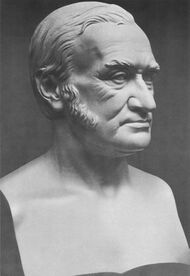
Mechanics
Gauss' first and last business in mechanics concerned the earth's rotation. When his university friend Benzenberg carried out experiments to determine the deviation of falling masses from the perpendicular in 1802, what today is known as an effect of the Coriolis force, he asked Gauss for a theory based calculation of the values for comparison with the experimental ones. Gauss elaborated a system of fundamental equations for the motion, and his results correspondent sufficiently with Benzenberg's data, who published Gauss' considerations as appendix to his book on falling experiments.[178]
After Foucault had demonstrated his pendulum in public in 1851, Gerling questioned Gauss for further explanations. This instigated Gauss to design a new apparatus for demonstration with a much shorter length of pendulum than Foucault's one. The oscillations were observed with a reading telescope, with a vertical scale and a mirror fastened at the pendulum; the time of oscillation was 3.1 seconds. It is described in the Gauss–Gerling correspondence, and Weber made some experiments with this obviously working apparatus in 1853, but no data were published.[179][180]
Gauss's principle of least constraint of 1829 was established as a general concept to overcome the division of mechanics into statics and dynamics, combining D'Alembert's principle with Lagrange's principle of Virtual Work, and showing analogies to the method of least squares.[181]
Metrology
In 1828, Gauss was appointed to head of a Board for weights and measures of the Kingdom of Hanover. He provided the creation of standards of length and measures. Gauss himself took care of the time-consuming measures and gave detailed orders for the mechanical preparation.[114] In his correspondence with Schumacher, who was also working on this matter, he described new ideas for scales of high precision.[182] He gave his final reports on the Hanoveran foot and pound to the government in 1841. This work got more than regional importance by the order of a law of 1836, that connected the Hanoveran measures with the English ones.[114]
Anecdotes
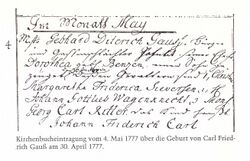
Several stories of his early genius have been reported. Carl Friedrich Gauss' mother had never recorded the date of his birth, remembering only that he had been born on a Wednesday, eight days before the Feast of the Ascension, which occurs 39 days after Easter.[183] Gauss later solved this puzzle about his birthdate in the context of finding the date of Easter, deriving methods to compute the date in both past and future years.[184] Gauss felt sorry for his new born daughter Wilhelmine, because she was born on the leap day in 1808 and thus would celebrate her birthday only every four years.[185]
In his memorial on Gauss, Wolfgang Sartorius von Waltershausen tells a story about the three-years-aged Gauss, who corrected a math error his father made. The most popular story, also told by Sartorius, tells of a school exercise: the teacher, J.G. Büttner, and his assistant, Martin Bartels, ordered students to add an arithmetic series. Out of about a hundred pupils, Gauss was the first to solve the problem correctly by a significant margin.[186] Although (or because) Sartorius gave no details, in the course of time many versions of this story have been created, with more and more details regarding the nature of the series – the most frequent being the classical problem of adding together all the integers from 1 to 100 – and the circumstances in the classroom.[187][lower-alpha 25]
Gauss' favorite English author was Walter Scott, but when he sometimes read the words "the moon rises broad in the nord west", he was very amused.[189]
Gauss referred to mathematics as "the queen of sciences" and arithmetics as "the queen of mathematics",[190] and supposedly once espoused a belief in the necessity of immediately understanding Euler's identity as a benchmark pursuant to becoming a first-class mathematician.[191]
Honours and awards

The first membership of a scientific society was given to Gauss in 1802 by the Russian Academy of Sciences. Further memberships (corresponding, foreign or full) were from the Academy of Sciences in Göttingen (1802/ 1807),[192] the French Academy of Sciences (1804/ 1820),[193] the Royal Society of London (1804),[194] the Royal Prussian Academy in Berlin (1810),[195] the National Academy of Science in Verona (1810),[196] the Royal Society of Edinburgh (1820),[197] the Bavarian Academy of Sciences of Munich (1820),[198] the Royal Danish Academy in Copenhagen (1821), the Royal Astronomical Society in London (1821),[199] the Royal Swedish Academy of Sciences (1821), the American Academy of Arts and Sciences in Boston (1822),[200] the Royal Bohemian Society of Sciences in Prague (1833), the Royal Academy of Science, Letters and Fine Arts of Belgium (1841/ 1845),[201] the Royal Society of Sciences in Uppsala (1843), the Royal Irish Academy in Dublin (1843), the Royal Institute of the Netherlands (1845/ 1851),[202] the Spanish Royal Academy of Sciences in Madrid (1850),[203] the Russian Geographical Society (1851), the Imperial Academy of Sciences in Vienna (1848), the American Philosophical Society (1853),[204] the Cambridge Philosophical Society, and the Royal Hollandish Society of Sciences in Haarlem.[205]
Gauss was an honorary member of the University of Kazan and of the Philosophy Faculty of the University of Prague since 1849.
Gauss received the Lalande Prize from the French Academy of Science in 1809 for the theory of planets and the means of determining their orbits from only three observations,[206] the Danish Academy of Science prize in 1823 for "his study of angle-preserving maps", and the Copley Medal from the Royal Society in 1838 for "his inventions and mathematical researches in magnetism".[205]
Gauss was appointed Knight of the French Legion of Honour[207] in 1837 and was one of the first members of the Prussian Order Pour le Merite (Civil class) when it was established in 1842.[208] Furthermore, he received the Order of the Crown of Westphalia (1810), the Danish Order of the Dannebrog (1817), the Hanoverian Royal Guelphic Order (1815), the Swedish Order of the Polar Star (1844), the Order of Henry the Lion (1849), and the Bavarian Maximilian Order for Science and Art (1853).[205]
The Kings of Hanover appointed him the honorary titles "Hofrath" (1816)[74] and "Geheimer Hofrath"[lower-alpha 26] (1845). On the occasion of his golden doctor degree jubilee he got the honorary citizenship of both towns of Brunswick and Göttingen in 1849.[205] Soon after his death a medal was issued by order of King George V of Hanover with the back side inscription : GEORGIVS V REX HANNOVERAE MATHEMATICORVM PRINCIPI and the circumscription : ACADEMIAE SVAE GEORGIAE AVGVSTAE DECORI AETERNO.[209]
The ″Gauss-Gesellschaft Göttingen″ (Gauss Society) was founded in 1964 for researches on life and work of Carl Friedrich Gauss and related persons and edits the ″Mitteilungen der Gauss-Gesellschaft″ (Communications of the Gauss Society).[210]
Writings
Mathematics and astronomy
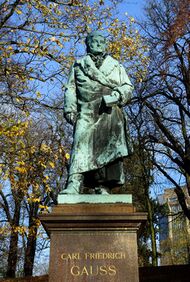
- 1799: Demonstratio nova theorematis omnem functionem algebraicam rationalem integram unius variabilis in factores reales primi vel secundi gradus resolvi posse. Helmstedt: C. G. Fleckeisen. https://gdz.sub.uni-goettingen.de/id/PPN235999628?tify=%7B%22pages%22%3A%5B5%5D%2C%22pan%22%3A%7B%22x%22%3A0.469%2C%22y%22%3A0.692%7D%2C%22view%22%3A%22info%22%2C%22zoom%22%3A0.422%7D. (Doctoral thesis on the fundamental theorem of algebra, University of Helmstedt) Original book
- 1816: "Demonstratio nova altera theorematis omnem functionem algebraicam rationalem integram unius variabilis in factores reales primi vel secundi gradus resolvi posse". Commentationes Societatis Regiae Scientiarum Gottingensis Recentiores. Comm. Class. Math. 3: 107–134. https://gdz.sub.uni-goettingen.de/id/PPN35283028X_0003_2NS?tify=%7B%22pages%22%3A%5B268%2C269%5D%2C%22view%22%3A%22info%22%7D.
- 1816: "Theorematis de resolubilitate functionum algebraicarum integrarum in factores reales demonstratio tertia". Commentationes Societatis Regiae Scientiarum Gottingensis Recentiores. Comm. Class. Math. 3: 135–142. https://gdz.sub.uni-goettingen.de/id/PPN35283028X_0003_2NS?tify=%7B%22pages%22%3A%5B296%5D%2C%22view%22%3A%22info%22%7D.
- 1850: "Beiträge zur Theorie der algebraischen Gleichungen". Abhandlungen der Königlichen Gesellschaft der Wissenschaften zu Göttingen 4: 34–35. https://gdz.sub.uni-goettingen.de/id/PPN250442582_0004?tify=%7B%22pages%22%3A%5B287%5D%2C%22view%22%3A%22info%22%7D.
- 1800: "Berechnung des Osterfestes" (in de). Monatliche Correspondenz zur Beförderung der Erd- und Himmelskunde 2: 121–130. https://zs.thulb.uni-jena.de/receive/jportal_jpvolume_00201970. (Calculation of the date of Easter)
- 1801: Disquisitiones Arithmeticae. Leipzig: Gerh. Fleischer jun.. https://gdz.sub.uni-goettingen.de/id/PPN235993352?tify=%7B%22pages%22%3A%5B5%5D%2C%22view%22%3A%22info%22%7D.
- Gauss, Carl Friedrich (1986). Disquisitiones Arithmeticae & other papers on number theory (2nd, corrected ed.). New York: Springer. doi:10.1007/978-1-4939-7560-0. ISBN 978-0-387-96254-2. https://link.springer.com/book/10.1007/978-1-4939-7560-0#about-this-book.
- 1802: "Berechnung des jüdischen Osterfestes" (in de). Monatliche Correspondenz zur Beförderung der Erd- und Himmelskunde 5: 435–437. https://zs.thulb.uni-jena.de/rsc/viewer/jportal_derivate_00237503/Monatlich_Correspondenz_130168688_5_1802_0444%20.tif. (Calculation of the date of Pesach)
- 1808: "Theorematis arithmetici demonstratio nova". Commentationes Societatis Regiae Scientiarum Gottingensis. Comm. Math. 16: 69–74. https://gdz.sub.uni-goettingen.de/id/PPN35283028X_0016_1NS?tify=%7B%22pages%22%3A%5B498%2C499%5D%2C%22view%22%3A%22info%22%7D. (Introduces Gauss's lemma, uses it in the third proof of quadratic reciprocity)
- 1809: Gauss, Carl Friedrich (in la). Theoria motus corporum coelestium in sectionibus conicis solem ambientium. Hamburg: Friedrich Perthes & Johann Heinrich Besser. https://gdz.sub.uni-goettingen.de/id/PPN236008730?tify=%7B%22pages%22%3A%5B7%5D%2C%22pan%22%3A%7B%22x%22%3A0.453%2C%22y%22%3A0.658%7D%2C%22view%22%3A%22info%22%2C%22zoom%22%3A0.507%7D.} Original book
- Gauss, Carl Friedrich (1857). Theory of the Motion of Heavenly Bodies Moving about the Sun in Conic Sections. Little, Brown & Co.. https://archive.org/details/theoryofmotionof00gausrich/.
- 1811: "Disquisitio de elementis ellipticis Palladis ex oppositionibus annorum 1803, 1804, 1805, 1806, 1807, 1808, 1809". Commentationes Societatis Regiae Scientiarum Gottingensis Recentiores. Comm. Math. 1: 1–26. https://gdz.sub.uni-goettingen.de/id/PPN35283028X_0001_2NS?tify=%7B%22pages%22%3A%5B170%2C171%5D%2C%22view%22%3A%22info%22%7D. (Orbit of Pallas)
- 1811: "Summatio quarundam serierum singularium". Commentationes Societatis Regiae Scientiarum Gottingensis Recentiores. Comm. Class. Math. 1: 1–40. https://gdz.sub.uni-goettingen.de/id/PPN35283028X_0001_2NS?tify=%7B%22pages%22%3A%5B194%2C195%5D%2C%22view%22%3A%22info%22%7D. (Determination of the sign of the quadratic Gauss sum, uses this to give the fourth proof of quadratic reciprocity)
- 1812: "Disquisitiones generales circa seriem infinitam ". Commentationes Societatis Regiae Scientiarum Gottingensis Recentiores. Comm. Class. Math. 2: 1–42. https://gdz.sub.uni-goettingen.de/id/PPN35283028X_0002_2NS?tify=%7B%22pages%22%3A%5B227%5D%2C%22pan%22%3A%7B%22x%22%3A0.559%2C%22y%22%3A0.496%7D%2C%22view%22%3A%22info%22%2C%22zoom%22%3A0.456%7D.
- 1815: "Methodus nova integralium valores per approximationem inveniendi". Commentationes Societatis Regiae Scientiarum Gottingensis Recentiores. Comm. Class. Math. 3: 39–76. https://gdz.sub.uni-goettingen.de/id/PPN35283028X_0003_2NS?tify=%7B%22pages%22%3A%5B200%2C201%5D%2C%22view%22%3A%22info%22%7D.
- 1818: "Theorematis fundamentalis in doctrina de residuis quadraticis demonstrationes et ampliationes novae". Commentationes Societatis Regiae Scientiarum Gottingensis Recentiores. Comm. Class. Math. 4: 3–20. https://gdz.sub.uni-goettingen.de/id/PPN35283028X_0004_2NS?tify=%7B%22pages%22%3A%5B262%2C263%5D%2C%22view%22%3A%22info%22%7D. (Fifth and sixth proofs of quadratic reciprocity)
- 1818: "Demonstratio attractionis, quam in punctum positionis datae exerceret planeta, si eius massa per totamorbitam, ratione temporis, quo singulae partes describuntur, uniformiter esset dispertita". Commentationes Societatis Regiae Scientiarum Gottingensis Recentiores. Comm. Class. Math. 4: 21–48. https://gdz.sub.uni-goettingen.de/id/PPN35283028X_0004_2NS?tify=%7B%22pages%22%3A%5B281%5D%2C%22pan%22%3A%7B%22x%22%3A0.499%2C%22y%22%3A0.677%7D%2C%22view%22%3A%22info%22%2C%22zoom%22%3A0.434%7D.
- 1821: "Theoria combinationis observationum erroribus minimis obnoxiae. Pars Prior". Commentationes Societatis Regiae Scientiarum Gottingensis Recentiores. Comm. Class. Math. 5: 33–62. https://gdz.sub.uni-goettingen.de/id/PPN35283028X_0005_2NS?tify=%7B%22pages%22%3A%5B276%5D%2C%22view%22%3A%22info%22%7D.
- 1823: "Theoria combinationis observationum erroribus minimis obnoxiae. Pars Posterior". Commentationes Societatis Regiae Scientiarum Gottingensis Recentiores. Comm. Class. Math. 5: 63–90. https://gdz.sub.uni-goettingen.de/id/PPN35283028X_0005_2NS?tify=%7B%22pages%22%3A%5B306%5D%2C%22pan%22%3A%7B%22x%22%3A0.413%2C%22y%22%3A0.66%7D%2C%22view%22%3A%22info%22%2C%22zoom%22%3A0.413%7D.
- 1828: Gauss, Carl Friedrich (1828). "Supplementum theoriae combinationis observationum erroribus minimis obnoxiae". Commentationes Societatis Regiae Scientiarum Gottingensis Recentiores. Comm. Class. Math. (Dieterich) 6: 57–98. Bibcode: 1828stco.book.....G. https://gdz.sub.uni-goettingen.de/id/PPN35283028X_0006_2NS?tify=%7B%22pages%22%3A%5B271%5D%2C%22view%22%3A%22info%22%7D. (Three essays concerning the calculation of probabilities as the basis of the Gaussian law of error propagation)
- Gauss, Carl Friedrich; Stewart, G. W. (1995). Theory of the Combination of Observations Least Subject to Errors. Part One, Part Two, Supplement (Classics in Applied Mathematics). Philadelphia: Society for Industrial and Applied Mathematics. doi:10.1137/1.9781611971248. ISBN 978-0-89871-347-3. https://epubs.siam.org/doi/book/10.1137/1.9781611971248.
- 1828: "Disquisitiones generales circa superficies curvas". Commentationes Societatis Regiae Scientiarum Gottingensis Recentiores. Comm. Class. Math. 6: 99–146. https://gdz.sub.uni-goettingen.de/id/PPN35283028X_0006_2NS?tify=%7B%22pages%22%3A%5B312%2C313%5D%2C%22view%22%3A%22info%22%7D.
- General Investigations of Curved Surfaces. The Princeton University Library. 1902. https://www.gutenberg.org/files/36856/36856-pdf.pdf.
- 1828: "Theoria residuorum biquadraticorum, Commentatio prima". Commentationes Societatis Regiae Scientiarum Gottingensis Recentiores. Comm. Class. Math. 6: 27–56. https://gdz.sub.uni-goettingen.de/id/PPN35283028X_0006_2NS?tify=%7B%22pages%22%3A%5B241%5D%2C%22view%22%3A%22info%22%7D.
- 1832: "Theoria residuorum biquadraticorum, Commentatio secunda". Commentationes Societatis Regiae Scientiarum Gottingensis Recentiores. Comm. Class. Math. 7: 89–148. https://gdz.sub.uni-goettingen.de/id/PPN35283028X_0007_2NS?tify=%7B%22pages%22%3A%5B273%5D%2C%22view%22%3A%22info%22%7D. (Introduces the Gaussian integers, states (without proof) the law of biquadratic reciprocity, proves the supplementary law for 1 + i)
- 1845: "Untersuchungen über Gegenstände der Höheren Geodäsie. Erste Abhandlung". Abhandlungen der Königlichen Gesellschaft der Wissenschaften in Göttingen Zweiter Band: 3–46. https://gdz.sub.uni-goettingen.de/id/PPN250442582_0002.
- 1847: "Untersuchungen über Gegenstände der Höheren Geodäsie. Zweite Abhandlung". Abhandlungen der Königlichen Gesellschaft der Wissenschaften in Göttingen Dritter Band: 3–44. https://gdz.sub.uni-goettingen.de/id/PPN250442582_0003.
- Klein, Felix, ed. (1903), "Gauß' wissenschaftliches Tagebuch 1796–1814" (in la, de), Mathematische Annalen 57: 1–34, doi:10.1007/BF01449013, https://gdz.sub.uni-goettingen.de/id/PPN235181684_0057?tify=%7B%22pages%22%3A%5B8%2C9%5D%2C%22view%22%3A%22info%22%7D Original book
- Jeremy Gray (1984). "A commentary on Gauss's mathematical diary, 1796–1814". Expositiones Mathematicae 2: 97–130.
Physics
- 1804: Gauss, Carl Friedrich. "Fundamentalgleichungen für die Bewegung schwerer Körper auf der Erde". Versuche über das Gesetz des Falls, über den Widerstand der Luft und über die Umdrehung der Erde. Dortmund: Gebrüder Mallinckrodt. pp. 363–371. https://www.digitale-sammlungen.de/de/view/bsb10060427?page=392,393.
- 1813: "Theoria attractionis corporum sphaeroidicorum ellipticorum homogeneorum methodo nova tractata". Commentationes Societatis Regiae Scientiarum Gottingensis Recentiores. Comm. Class. Math. 2: 1–24. https://gdz.sub.uni-goettingen.de/id/PPN35283028X_0002_2NS?tify=%7B%22pages%22%3A%5B318%5D%2C%22pan%22%3A%7B%22x%22%3A0.539%2C%22y%22%3A0.64%7D%2C%22view%22%3A%22info%22%2C%22zoom%22%3A0.456%7D.
- 1817: "Ueber die achromatischen Doppelobjective besonders in Rücksicht der vollkommnern Aufhebung der Farbenzerstreuung" (in de). Zeitschrift für Astronomie und verwandte Wissenschaften IV: 345–351. https://babel.hathitrust.org/cgi/pt?id=hvd.hxigq8&seq=349.
- 1829: "Über ein neues allgemeines Grundgesetz der Mechanik". Journal für die reine und angewandte Methematik (Crelle's Journal) 1829 (4): 232–235. 1829. doi:10.1515/crll.1829.4.232. https://zenodo.org/record/1448816.
- 1832: "Principia generalia theoriae figurae fluidorum fluidorum in statu aequilibrii". Commentationes Societatis Regiae Scientiarum Gottingensis Recentiores 7: 39–88. https://gdz.sub.uni-goettingen.de/id/PPN35283028X_0007_2NS?tify=%7B%22pages%22%3A%5B223%5D%2C%22view%22%3A%22info%22%7D.
- 1841: "Intensitas vis magneticae terrestris ad mensuram absolutam revocata". Commentationes Societatis Regiae Scientiarum Gottingensis Recentiores 8: 3–44. https://gdz.sub.uni-goettingen.de/id/PPN35283028X_0008_2NS?tify=%7B%22pages%22%3A%5B198%5D%2C%22pan%22%3A%7B%22x%22%3A0.569%2C%22y%22%3A0.65%7D%2C%22view%22%3A%22info%22%2C%22zoom%22%3A0.449%7D.
- The Intensity of the Earth's Magnetic Force Reduced to Absolute Measurement. Translated by Susan P. Johnson.
- 1836: H.C. Schumacher, ed. "Erdmagnetismus und Magnetometer" (in de). Jahrbuch für 1836 (Tübingen: J.G.Cotta'sche Buchhandlung) 1836: 1–47. https://www.digitale-sammlungen.de/de/view/bsb10538569?page=21.
- 1840: (in de) Allgemeine Lehrsätze in Beziehung auf die im verkehrten Verhältnis des Quadrats der Entfernung wirkenden Anziehungs- und Abstoßungskräfte. Leipzig: Weidmannsche Buchhandlung. 1840. https://www.deutschestextarchiv.de/book/show/gauss_lehrsaetze_1840.
- 1843: "Dioptrische Untersuchungen" (in de). Abhandlungen der Königlichen Gesellschaft der Wissenschaften in Göttingen Erster Band: 1–34. https://gdz.sub.uni-goettingen.de/id/PPN250442582_0001?tify=%7B%22pages%22%3A%5B548%2C549%5D%2C%22view%22%3A%22info%22%7D.
together with Wilhelm Weber
- 1837–1839: (in de) Resultate aus den Beobachtungen des magnetischen Vereins im Jahre 1836–1838. Göttingen: Dieterichsche Buchhandlung. https://babel.hathitrust.org/cgi/pt?id=njp.32101058086446&view=1up&seq=9.
- 1840–1843: (in de) Resultate aus den Beobachtungen des magnetischen Vereins im Jahre 1839–1841. Leipzig: Weidmannsche Verlagsbuchhandlung. https://babel.hathitrust.org/cgi/pt?id=njp.32101058086396&view=1up&seq=199.
- 1840: (in de) Atlas des Erdmagnetismus nach den Elementen der Theorie entworfen. Supplement zu den Resultaten aus den Beobachtungen des magnetischen Vereins. Leipzig: Weidmannsche Verlagsbuchhandlung. https://babel.hathitrust.org/cgi/pt?id=njp.32101058086388&view=1up&seq=5.
Collected works
- Königlich Preußische Akademie der Wissenschaften, ed (1863–1933) (in la, de). Carl Friedrich Gauss. Werke. 1–12. Göttingen: (diverse publishers). https://gdz.sub.uni-goettingen.de/id/PPN235957348?tify=%7B%22view%22:%22toc%22%7D.
Correspondence
- Königlich Preußische Akademie der Wissenschaften, ed (1880) (in de). Briefwechsel zwischen Gauss und Bessel. Leipzig: Wilhelm Engelmann. https://archive.org/details/briefwechselzwi00berlgoog/page/n5/mode/2up. (letters from December 1804 to August 1844)
- Schoenberg, Erich; Perlick, Alfons (1955) (in de). Unbekannte Briefe von C. F. Gauß und Fr. W. Bessel. Abhandlungen der Bayerischen Akademie der Wissenschaften, Math.-nat. Klasse, Neue Folge, No. 71. Munich: Verlag der Bayerischen Akademie der Wissenschaften. pp. 5–21. (letters to Boguslawski from February 1835 to January 1848)
- Schwemin, Friedhelm, ed (2014) (in de). Der Briefwechsel zwischen Carl Friedrich Gauß und Johann Elert Bode. Acta Historica Astronomica. 53. Leipzig: Akademische Verlaganstalt. ISBN 978-3-944913-43-8. (letters from February 1802 to October 1826)
- Franz Schmidt, Paul Stäckel, ed (1899) (in de). Briefwechsel zwischen Carl Friedrich Gauss und Wolfgang Bolyai. Leipzig: B. G. Teubner. https://archive.org/details/briefwechselzwi00gausgoog/page/n4/mode/2up. (letters from September 1797 to February 1853; added letters of other correspondents)
- Axel Wittmann, ed (2018) (in de). Obgleich und indeßen. Der Briefwechsel zwischen Carl Friedrich Gauss und Johann Franz Encke. Remagen: Verlag Kessel. ISBN 978-3945941379. (letters from June 1810 to June 1854)
- Clemens Schaefer, ed (1927) (in de). Briefwechsel zwischen Carl Friedrich Gauss und Christian Ludwig Gerling. Berlin: Otto Elsner. https://gdz.sub.uni-goettingen.de/id/PPN335994989?tify=%7B%22pages%22%3A%5B5%5D%2C%22view%22%3A%22info%22%7D. (letters from June 1810 to June 1854)
- Karl Christian Bruhns, ed (1877) (in de). Briefe zwischen A. v. Humboldt und Gauss. Leipzig: Wilhelm Engelmann. https://archive.org/details/briefezwischena00gausgoog/page/n5/mode/2up. (letters from July 1807 to December 1854; added letters of other correspondents)
- Reich, Karin; Roussanova, Elena (2018) (in de). Karl Kreil und der Erdmagnetismus. Seine Korrespondenz mit Carl Friedrich Gauß im historischen Kontext. Veröffentlichungen der Kommission für Geschichte der Naturwissenschaften, Mathematik und Medizin, No. 68. Vienna: Verlag der Österreichischen Akademie der Wissenschaften. (letters from 1835 to 1843)
- Gerardy, Theo, ed (1959) (in de). Briefwechsel zwischen Carl Friedrich Gauß und Carl Ludwig von Lecoq. Abhandlungen der Akademie der Wissenschaften in Göttingen, Mathematisch-Physikalische Klasse, No. 4. Göttingen: Vandenhoeck & Ruprecht. pp. 37–63. (letters from February 1799 to September 1800)
- Forbes, Eric G. (1971). "The Correspondence between Carl Friedrich Gauss and the Rev. Nevil Maskelyne (1802-05)". Annals of Science 27 (3): 213–237. doi:10.1080/00033797100203767. https://www.tandfonline.com/doi/abs/10.1080/00033797100203767.
- Carl Schilling, ed (1900) (in de). Briefwechsel zwischen Olbers und Gauss: Erste Abtheilung. Wilhelm Olbers. Sein Leben und seine Werke. Zweiter Band. Berlin: Julius Springer. https://archive.org/details/p1wilhelmolberss02olbeuoft/page/n5/mode/2up. (letters from January 1802 to October 1819)
- Carl Schilling, ed (1909) (in de). Briefwechsel zwischen Olbers und Gauss: Zweite Abtheilung. Wilhelm Olbers. Sein Leben und seine Werke. Zweiter Band. Berlin: Julius Springer. https://archive.org/details/p2wilhelmolberss02olbeuoft/page/n7/mode/2up. (letters from January 1820 to May 1839; added letters of other correspondents)
- Christian August Friedrich Peters, ed (1860–1865) (in de). Briefwechsel zwischen C. F. Gauss und H. C. Schumacher. Altona: Gustav Esch.
- Volumes 1+2 (letters from April 1808 to March 1836)
- Volumes 3+4 (letters from March 1836 to April 1845)
- Volumes 5+6 (letters from April 1845 to November 1850)
- Poser, Hans, ed (1987) (in de). Briefwechsel zwischen Carl Friedrich Gauß und Eberhard August Zimmermann. Abhandlungen der Akademie der Wissenschaften in Göttingen, Mathematisch-Physikalische Klasse, Folge 3, No. 39. Göttingen: Vandenhoeck & Ruprecht. ISBN 978-3525821169. (letters from 1795 to 1815)
-
Title page of Gauss' magnum opus, Disquisitiones Arithmeticae (1801)
-
Title of Theorema arithmetici demonstratio nova (1808)
-
Title page of Theoria Motus Corporum Coelestium in sectionibus conicis solem ambientium (1809)
-
Title page to the English Translation of Theoria Motus by Charles Henry Davis (1857)
-
Title page of Intensitas vis Magneticae Terrestris ad Mensuram Absolutam Revocata (1833)
-
Volume II of "Carl Friedrich Gauss Werke," 1876
The Göttingen Academy of Sciences and Humanities provides a complete collection of the yet known letters from and to Carl Friedrich Gauss that is accessible online.[66] Written estate from Carl Friedrich Gauss and family members can also be found in the municipal archive of Brunswick.[211]
Names and Commemorations
- List of things named after Carl Friedrich Gauss
References
Notes
- ↑ St. Catherine's church
- ↑ The Collegium Carolinum was the preceding institution of the Technische Hochschule Braunschweig, now Braunschweig Institute of Technology, but at Gauss' time not equal to a university.
- ↑ This error occurs for example in Marsden (1977).[23]
- ↑ On this journey he met the geodesist Ferdinand Rudolph Hassler, who was a scientific correspondent of Carl Friedrich Gauss.[47][48]
- ↑ Gauss himself, in a letter to Bolyai, complained about "the shallowness that is so dominating in our contemporary mathematics".[51]
- ↑ The index of correspondence shows that Benjamin Gould was presumably the last correspondent who sent a letter to Gauss in his lifetime. It was an actual letter of farewell, but it is uncertain whether it reached the addressee just in time.[66]
- ↑ After his death, a discourse on the perturbations of Pallas in French was found among his papers, probably as a contribution to a prize competition of the French Academy of Science.[69]
- ↑ Both Gauss and Harding dropped only veiled hints on this personal problem in their correspondence. A letter to Schumacher indicates that Gauss tried to get rid of his colleague and searched for a new position for him outside of Göttingen, but without result. Apart from that, Charlotte Waldeck, Gauss' mother-in-law, pleaded with Olbers to try to provide Gauss with another position far from Göttingen.
- ↑ Bessel never had a university education.
- ↑ The first book he loaned from the university library in 1795 was the novel Clarissa from Samuel Richardson.[87]
- ↑ The political background was the confusing situation of the German Confederation with 39 nearly independent states, the sovereigns of three of them being Kings of other countries (Netherlands, Danmark, United Kingdom), whereas Prussia and Austria extended widely over the frontiers of the Confederation.
- ↑ Especially entry 146 in his diary is now seen as a prelude to the modern developments associated with Weil conjectures and the tools of algebraic geometry.[100]
- ↑ Gauss already dealt implicitly with fundamental domains in his Disquisitions Arithmeticae (1801), in the context of reduction theory of binary quadratic forms, but this geometric sketch appears for the first time in his analytic work on the AGM.
- ↑ The unambigeous identification of a cosmic object as planet among the fixed stars requires at least two observations with interval.
- ↑ Brendel (1929) thought this cipher to be insoluble, but actually decoding was very easy.[122]
- ↑ This article is also noteworthy because it was Gauss's only published reference to his (mostly unpublished) work on the AGM algorithm.
- ↑ In 1947, Andrey Kolmogorov corrected a mistake he found in Gauss's formula for the lower bound.
- ↑ Lauenburg is in the southernmost place of the Duchy of Holstein, that was held in personal union by the King of Denmark .
- ↑ This Ramsden sector was loaned by the Board of Ordnance, and had earlier been used by William Mudge in the Principal Triangulation of Great Britain.[135]
- ↑ The new value of about 1/298.39 what was a significant improvement against the former value of 1/302.78 from Walbeck (1820). The calculation was done by Eduard Schmidt, private lecturer at Göttingen University.[137]
- ↑ In pp.73-74 of his essay on Gauss's contributions to calculus of variations, Oskar Bolza mentions a transformation for the expression of geodesic curvature, that Gauss gives at the last section of this manuscript, which is "the actual core not only of Gauss's theorem about total curvature, but also of Bonnet's later generalization (1848)".
- ↑ As a result, there are only indirect reports by his colleagues and students Mobius, Listing and Riemann as testimony to his influence.
- ↑ These navigational tasks appear as problems no. 78,79 in Heinrich Dörrie's book "100 Great Problems Of Elementary Mathematics". Their solutions by Gauss were published in 1812 as part of Bode's Astronomisches Jahrbuch.
- ↑ A thunderstorm damaged the cable in 1845.[170]
- ↑ Some authors, such as Joseph J. Rotman, question whether it ever happened.[188]
- ↑ literally translation: Secrete Councillor of the court
Citations
- ↑ "On Jensen's Paintings of C. F. Gauss". Mitteilungen der Gauss-Gesellschaft (46): 57–61. 2009. http://www.gauss-gesellschaft-goettingen.de/mitteil.html#2009.
- ↑ Dudenredaktion; Kleiner, Stefan; Knöbl, Ralf (2015) (in de). Das Aussprachewörterbuch (7th ed.). Berlin: Dudenverlag. pp. 246, 381, 391. ISBN 978-3-411-04067-4. https://books.google.com/books?id=T6vWCgAAQBAJ.
- ↑ Krech, Eva-Maria; Stock, Eberhard; Hirschfeld, Ursula; Anders, Lutz Christian (2009) (in de). Deutsches Aussprachewörterbuch. Berlin: Walter de Gruyter. pp. 402, 520, 529. ISBN 978-3-11-018202-6. https://books.google.com/books?id=E-1tr_oVkW4C&q=deutsches+ausspracheworterbuch.
- ↑ 4.0 4.1 4.2 Dunnington, Waldo (1927). "The Sesquicentennial of the Birth of Gauss". The Scientific Monthly 24 (5): 402–414. Bibcode: 1927SciMo..24..402D. http://www.mathsong.com/cfgauss/Dunnington/1927/. Also available at "T he Sesquicentennial of the Birth of Gauss". http://gausschildren.org/genwiki/index.php?title=The_Sesquicentennial_of_the_Birth_of_Gauss. Retrieved 23 February 2014. Comprehensive biographical article.
- ↑ Heideman·, Michael T.; Johnson, Don H.; Burrus, C. Sydney (1985-09-01). "Gauss and the History of the Fast Fourier Transform". Archive for History of Exact Sciences 34 (3): 265–277. doi:10.1007/BF00348431. https://www.cis.rit.edu/class/simg716/Gauss_History_FFT.pdf.
- ↑ Schaaf, William L. (1964) (in en). Carl Friedrich Gauss: Prince of Mathematicians. Franklin Watts. pp. 84. https://archive.org/details/carlfriedrichgau0000unse.
- ↑ 7.0 7.1 Plackett, R.L. (1972). "The discovery of the method of least squares". Biometrika 59 (2): 239–251. https://hedibert.org/wp-content/uploads/2016/08/plackett1972-thediscoveryofthemethodofleastsquares.pdf.
- ↑ 8.0 8.1 Stigler, Stephen M. (1981). "Gauss and the Invention of Least Squares". The Annals of Statistics 9 (3): 465–474. doi:10.1214/aos/1176345451. ISSN 0090-5364.
- ↑ Lim, Milton (2021-03-31). "Gauss, Least Squares, and the Missing Planet". https://www.actuaries.digital/2021/03/31/gauss-least-squares-and-the-missing-planet/.
- ↑ Klein, Felix (1924) (in en). Elementary Mathematics from an Advanced Standpoint: Geometry. Dover Publications. pp. 176–177. ISBN 978-0486434810. https://archive.org/details/elementarymathem0000klei/mode/1up.
- ↑ 11.0 11.1 Winger, R. M. (1925). "Gauss and non-euclidean geometry". Bulletin of the American Mathematical Society 31 (7): 356–358. doi:10.1090/S0002-9904-1925-04054-9. ISSN 0002-9904. https://projecteuclid.org/journals/bulletin-of-the-american-mathematical-society/volume-31/issue-7/Gauss-and-non-euclidean-geometry/bams/1183486559.full.
- ↑ Schaaf, William L. (1964) (in en). Carl Friedrich Gauss: Prince of Mathematicians. Franklin Watts. pp. 128–140. https://archive.org/details/carlfriedrichgau0000unse.
- ↑ Jenkovszky, László; Lake, Matthew J.; Soloviev, Vladimir (2023-03-12). "János Bolyai, Carl Friedrich Gauss, Nikolai Lobachevsky and the New Geometry: Foreword" (in en). Symmetry 15 (3): 707. doi:10.3390/sym15030707. ISSN 2073-8994. Bibcode: 2023Symm...15..707J.
- ↑ Schaaf, William L. (1964) (in en). Carl Friedrich Gauss: Prince of Mathematicians. Franklin Watts. pp. 81. https://archive.org/details/carlfriedrichgau0000unse.
- ↑ Schaaf, William L. (1964) (in en). Carl Friedrich Gauss: Prince of Mathematicians. Franklin Watts. pp. 115–127. https://archive.org/details/carlfriedrichgau0000unse.
- ↑ Rudolf Borch (1929) : Ahnentafel des Mathematikers Carl Friedrich Gauß [Genealogical table]. Ahnentafeln Berühmter Deutscher, Vol. 1, pp. 63–65. Zentralstelle für Deutsche Personen- und Familiengeschichte (ed.)
- ↑ Chamberless, Susan (11 March 2000). "Letter:Worthington, Helen to Carl F. Gauss – 26 July 1911". Susan D. Chamberless. http://www.gausschildren.org/genwiki/index.php?title=Letter:WORTHINGTON,_Helen_to_Carl_F._Gauss_-_1911-07-26.
- ↑ Dunnington 2004, pp. 398–404.
- ↑ 19.0 19.1 Dunnington 2004, p. 24.
- ↑ Dunnington 2004, p. 26.
- ↑ O'Connor, John J.; Robertson, Edmund F., "Carl Friedrich Gauss", MacTutor History of Mathematics archive, University of St Andrews, http://www-history.mcs.st-andrews.ac.uk/Biographies/Gauss.html.
- ↑ Dunnington 2004, p. 28.
- ↑ 23.0 23.1 23.2 Marsden, Brian G. (1977-08-01). "Carl Friedrich Gauss, Astronomer". Journal of the Royal Astronomical Society of Canada 71: 309–323. ISSN 0035-872X. Bibcode: 1977JRASC..71..309M. http://adsabs.harvard.edu/abs/1977JRASC..71..309M.
- ↑ Michling, Horst (1966). "Zum Projekt einer Gauß-Sternwarte in Braunschweig" (in de). Mitteilungen der Gauß-Gesellschaft Göttingen (3): 24.
- ↑ Dunnington 2004, pp. 50, 54–55, 74–77.
- ↑ Dunnington 2004, pp. 86–87.
- ↑ Brendel 1929, pp. 81–82.
- ↑ Brendel 1929, p. 49.
- ↑ Brendel 1929, p. 83.
- ↑ Brendel 1929, p. 84.
- ↑ Brendel 1929, p. 119.
- ↑ Brendel 1929, p. 56.
- ↑ Klein 1979, p. 7.
- ↑ Brendel 1929, p. 144.
- ↑ Wagner, Rudolf (1860). Über die typischen Verschiedenheiten der Windungen der Hemisphären und über die Lehre vom Hirngewicht, mit besondrer Rücksicht auf die Hirnbildung intelligenter Männer. Vorstudien zu einer wissenschaftlichen Morphologie und Physiologie des menschlichen Gehirns als Seelenorgan, Vol. 1. Göttingen: Dieterich. https://books.google.com/books?id=YqTH2HDXgqkC&q=%C3%9Cber+die+typischen+Verschiedenheiten+der+Windungen+der+Hemisph%C3%A4ren+und+%C3%BCber+die+Lehre+vom+Hirngewicht,+mit+besondrer+R%C3%BCcksicht+auf+die+Hirnbildung+intelligenter+M%C3%A4nner.+Vorstudie.
- ↑ Wagner, Rudolf (1862). Über den Hirnbau der Mikrocephalen mit vergleichender Rücksicht auf den Bau des Gehirns der normalen Menschen und der Quadrumanen. Vorstudien zu einer wissenschaftlichen Morphologie und Physiologie des menschlichen Gehirns als Seelenorgan, Vol. 2. Göttingen: Dieterich. https://books.google.com/books?id=czvfLAp94VsC&q=%C3%9Cber+den+Hirnbau+der+Mikrocephalen+mit+vergleichender+R%C3%BCcksicht+auf+den+Bau+des+Gehirns+der+normalen+Menschen+und+der+Quadrumanen.+Vorstudien+zu+einer+wissenschaftlichen+Morphologie+und+Physiologie+des+menschlichen+Gehirns+als+S.
- ↑ Wagner, Hermann (1864) (in de). Maassbestimmungen der Oberfläche des grossen Gehirns. Cassel & Göttingen: Georg H. Wigand. https://books.google.com/books?id=8ToAAAAAQAAJ&q=Maassbestimmungen+der+Oberfl%C3%A4che+des+grossen+Gehirns.
- ↑ Bardi, Jason (2008). The Fifth Postulate: How Unraveling A Two Thousand Year Old Mystery Unraveled the Universe. John Wiley & Sons, Inc.. p. 189. ISBN 978-0-470-46736-7.
- ↑ Wolfgang Hänicke, Jens Frahm und Axel D. Wittmann: Magnetresonanz-Tomografie des Gehirns von Carl Friedrich Gauß. In: MPI News 5, Heft 12, 1999
- ↑ Schweizer, Renate; Wittmann, Axel; Frahm, Jens (2014). "A rare anatomical variation newly identifies the brains of C.F. Gauss and C.H. Fuchs in a collection at the University of Göttingen". Brain 137 (4): e269. doi:10.1093/brain/awt296. PMID 24163274. (with further references)
- ↑ "Unravelling the true identity of the brain of Carl Friedrich Gauss". https://www.mpg.de/7589532/Carl_Friedrich_Gauss_brain.
- ↑ "Johanna Osthoff 1780–1809 – Ancestry" (in en-us). https://www.ancestry.com/genealogy/records/johanna-osthoff-24-30lwhs.
- ↑ Cajori, Florian (19 May 1899). "Carl Friedrich Gauss and his children". Science. New Series (American Association for the Advancement of Science) 9 (229): 697–704. doi:10.1126/science.9.229.697. PMID 17817224. Bibcode: 1899Sci.....9..697C. https://www.jstor.org/stable/1626244.
- ↑ Dunnington 2004, p. 374.
- ↑ Dunnington 2004, p. 206.
- ↑ 46.0 46.1 46.2 46.3 46.4 Gerardy, Theo (1966). "C. F. Gauß und seine Söhne" (in de). Mitteilungen der Gauß-Gesellschaft Göttingen (3): 25–35.
- ↑ Gerardy, Theo (1977). "Geodäten als Korrespondenten von Carl Friedrich Gaus" (in de). Allgemeine Vermessungs-Nachrichten (84): 150–160. p.157
- ↑ Dunnington 2004, p. 286.
- ↑ "Der Pädagoge und Philosoph Johann Conrad Fallenstein (1731–1813) – Genealogische Beziehungen zwischen Max Weber, Gauß und Bessel" (in de). Genealogie 7: 266–269. 1964.
- ↑ "Carl Friedrich Gauß 1777–1855 und seine Nachkommen" (in de). Archiv für Sippenforschung und alle verwandten Gebiete 43/44 (66): 73–98. 1977.
- ↑ Ullrich, Peter (2005). "Herkunft, Schul- und Studienzeit von Carl Friedrich Gauß". in Mittler, Elmar. "Wie der Blitz einschlägt, hat sich das Räthsel gelöst" – Carl Friedrich Gauß in Göttingen. Göttinger Bibliotheksschriften 30. Niedersächsische Staats- und Universitätsbibliothek. pp. 17–29. ISBN 3-930457-72-5. http://webdoc.sub.gwdg.de/ebook/e/2005/gausscd/html/Katalog.pdf.
- ↑ Schubring, Gert (1993). "The German mathematical community". Möbius and his band: Mathematics and Astronomy in Nineteenth-century Germany. Oxford University Press. pp. 21–33.
- ↑ Klein 1979, p. 5-6.
- ↑ Dunnington 2004, p. 217.
- ↑ Klein, Felix (1894). "The Development of Mathematics at the German Universities". Lectures on Mathematics. New York, London: Macmillan and Co.. pp. 99–101. https://archive.org/details/lecturesonmathem00klei/page/n108/mode/2up. quotation p. 109
- ↑ Letter from Gauss to Bolyai from 2 September 1808
- ↑ 57.0 57.1 57.2 57.3 57.4 Biermann, Kurt-R. (1966). "Über die Beziehungen zwischen C. F. Gauß und F. W. Bessel" (in de). Mitteilungen der Gauß-Gesellschaft Göttingen (3): 7–20.
- ↑ Klein 1979, p. 29.
- ↑ Dunnington 2004, p. 420–430.
- ↑ Bell, E.T. (2009). "Ch. 14: The Prince of Mathematicians: Gauss". Men of Mathematics: The Lives and Achievements of the Great Mathematicians from Zeno to Poincaré. New York: Simon and Schuster. pp. 218–269. ISBN 978-0-671-46400-4.
- ↑ 61.0 61.1 Stigler, Stephen M. (1981). "Gauss and the Invention of Least Squares". Annals of Statistics 9 (3): 465–474. doi:10.1214/aos/1176345451.
- ↑ 62.0 62.1 Maennchen 1930, p. 4–9.
- ↑ Reich, Karin (2005). "Logarithmentafeln – Gauß' "tägliches Arbeitsgeräth"". in Mittler, Elmar. "Wie der Blitz einschlägt, hat sich das Räthsel gelöst" – Carl Friedrich Gauß in Göttingen. Göttinger Bibliotheksschriften 30. Niedrsächsische Staats- und Universitätsbibliothek. pp. 73–86. ISBN 3-930457-72-5. http://webdoc.sub.gwdg.de/ebook/e/2005/gausscd/html/Katalog.pdf.
- ↑ Maennchen 1930, p. 3.
- ↑ Dunnington 2004, p. 405–410.
- ↑ 66.0 66.1 "Der komplette Briefwechsel von Carl Friedrich Gauss". Akademie der Wissenschaften zu Göttingen. https://gauss.adw-goe.de/?locale-attribute=de.
- ↑ Reich, Karin (2000). "Gauß' Schüler" (in de). Mitteilungen der Gauß-Gesellschaft Göttingen (37): 33–62.
- ↑ Gauss, C. F. (1874). Königlich Preußische Akademie der Wissenschaften. ed (in de). Carl Friedrich Gauss. Werke. VI. pp. 73–86. https://gdz.sub.uni-goettingen.de/id/PPN236007467?tify=%7B%22pages%22%3A%5B77%5D%2C%22pan%22%3A%7B%22x%22%3A0.5%2C%22y%22%3A0.69%7D%2C%22view%22%3A%22info%22%2C%22zoom%22%3A0.413%7D.
- ↑ Brendel 1929, p. 211.
- ↑ Brendel 1929, pp. 7, 128.
- ↑ Küssner, Martha (1978). "Friedrich Wilhelm Bessels Beziehungen zu Göttingen und Erinnerungen an ihn" (in de). Mitteilungen der Gauß-Gesellschaft Göttingen (15): 3–19.
- ↑ Mackinnon, Nick (1990). "Sophie Germain, or, Was Gauss a feminist?". The Mathematical Gazette (The Mathematical Association) 74 (470): 346–351. doi:10.2307/3618130.
- ↑ Dunnington 2004, p. 195-200.
- ↑ 74.0 74.1 74.2 Dunnington 2004, p. 288.
- ↑ Sartorius von Waltershausen 1856, p. 102.
- ↑ 76.0 76.1 Sartorius von Waltershausen 1856, p. 95.
- ↑ Sartorius von Waltershausen 1856, p. 8.
- ↑ Sartorius von Waltershausen 1856, p. 68.
- ↑ 79.0 79.1 Sartorius von Waltershausen 1856, p. 100.
- ↑ Wußing 1982, p. 41.
- ↑ "Letter from Carl Friedrich Gauss to Johanna Gauss, 23. October 1809". Akademie der Wissenschaften zu Göttingen. 23 October 1809. https://gauss.adw-goe.de/handle/gauss/2086.
- ↑ Dunnington 2004, pp. 94–95.
- ↑ Dunnington 2004, p. 206, 374.
- ↑ "Letter: Charles Henry Gauss to Florian Cajori – 21 December 1898". https://homepages.rootsweb.com/~schmblss/home/Letters/Gauss/1898-12-21.htm.
- ↑ Sartorius von Waltershausen 1856, p. 71.
- ↑ Lehfeldt, Werner (2005). "Carl Friedrich Gauß' Beschäftigung mit der russischen Sprache". in Mittler, Elmar. "Wie der Blitz einschlägt, hat sich das Räthsel gelöst" – Carl Friedrich Gauß in Göttingen. Göttinger Bibliotheksschriften 30. Niedrsächsische Staats- und Universitätsbibliothek. pp. 302–310. ISBN 3-930457-72-5. http://webdoc.sub.gwdg.de/ebook/e/2005/gausscd/html/Katalog.pdf.
- ↑ Reich, Karin (2005). "Gauß' geistige Väter: nicht nur "summus Newton", sondern auch "summus Euler"". in Mittler, Elmar. "Wie der Blitz einschlägt, hat sich das Räthsel gelöst" – Carl Friedrich Gauß in Göttingen. Göttinger Bibliotheksschriften 30. Niedrsächsische Staats- und Universitätsbibliothek. pp. 105–115. ISBN 3-930457-72-5. http://webdoc.sub.gwdg.de/ebook/e/2005/gausscd/html/Katalog.pdf.
- ↑ Wußing 1982, p. 80.
- ↑ Wußing 1982, p. 81.
- ↑ 90.0 90.1 Sartorius von Waltershausen 1856, p. 94.
- ↑ Wußing 1982, p. 79.
- ↑ Sartorius von Waltershausen 1856, p. 97.
- ↑ "MacTutor". https://mathshistory.st-andrews.ac.uk/Biographies/Gauss/quotations/.
- ↑ Dunnington 2004, p. 300.
- ↑ Sartorius von Waltershausen 1856, p. 90.
- ↑ Gronwald, W. (1955). "Carl Friedrich Gauss – Ein Lebensbild". in Niedrsächsische Vermessungs- und Katasterverwaltung. Carl Friedrich Gauss und die Landesvermessung in Niedersachsen. Hannover. pp. 1–16. p. 12
- ↑ Basu, Soham; Velleman, Daniel J. (2017-04-21). "On Gauss's first proof of the fundamental theorem of algebra". arXiv:1704.06585 [math.CV].
- ↑ "Did Gauss know Dirichlet's class number formula in 1801?". MathOverflow. 10 October 2012. https://mathoverflow.net/q/109330.
- ↑ Weil, André (1949). "Numbers of solutions of equations in finite fields". Bulletin of the American Mathematical Society 55 (5): 497–508. doi:10.1090/S0002-9904-1949-09219-4. https://www.ams.org/journals/bull/1949-55-05/S0002-9904-1949-09219-4/S0002-9904-1949-09219-4.pdf.
- ↑ Königlich Preußische Akademie der Wissenschaften, ed (1917) (in la). Carl Friedrich Gauss. Werke. X, 1. Göttingen. p. 571. https://gdz.sub.uni-goettingen.de/id/PPN236018647?tify=%7B%22pages%22%3A%5B599%5D%2C%22pan%22%3A%7B%22x%22%3A0.436%2C%22y%22%3A0.834%7D%2C%22view%22%3A%22info%22%2C%22zoom%22%3A0.856%7D.
- ↑ Seeber, Ludwig August (1831). Untersuchungen über die Eigenschaften der positiven ternaeren quadratischen Formen. Mannheim. https://books.google.com/books?id=QKJGAAAAcAAJ.
- ↑ "Untersuchungen über die Eigenschaften der positiven ternären quadratischen Formen von Ludwig August Seeber". Göttingische gelehrte Anzeigen (108): 1065–1077. July 1831. https://babel.hathitrust.org/cgi/pt?id=mdp.39015064427944&seq=387.
- ↑ Roy, Ranjan (2021). Series and Products in the Development of Mathematics (2 ed.). Cambridge: Cambridge University Press. pp. 20–22. https://assets.cambridge.org/97811087/09453/frontmatter/9781108709453_frontmatter.pdf.
- ↑ Cox, David (January 1984). "The Arithmetic-Geometric Mean of Gauss". L'Enseignement mathématique 30 (2): 275–330. https://www.researchgate.net/publication/248675540.
- ↑ Schlesinger 1933, p. 136–142.
- ↑ Schlesinger 1933, p. 142.
- ↑ Monna, A. F. (1975). Dirichlet's principle : a mathematical comedy of errors and its influence on the development of analysis. Utrecht. pp. 11–12. https://www.gbv.de/dms/tib-ub-hannover/117505722.pdf.
- ↑ Letter Gauss to Gerling from 26 December 1823
- ↑ Yousef Saad (2019-08-02). "Iterative Methods for Linear Systems of Equations: A Brief Historical Journey". arXiv:1908.01083v1 [math.HO].
- ↑ Cooley, James W.; Tukey, John W. (1965). "An algorithm for the machine calculation of complex Fourier series". Mathematics of Computation 19 (90): 297–301. doi:10.2307/2003354.
- ↑ Gauss, C.F. (1876) (in la). Theoria Interpolationis Methodo Nova Tractata. Göttingen: K. Gesellschaft der Wissenschaften zu Göttingen. pp. 265–327. https://gdz.sub.uni-goettingen.de/id/PPN235999628?tify=%7B%22pages%22%3A%5B273%5D%2C%22pan%22%3A%7B%22x%22%3A0.524%2C%22y%22%3A0.333%7D%2C%22view%22%3A%22info%22%2C%22zoom%22%3A0.856%7D.
- ↑ Heideman, M.; Johnson, D.; Burrus, C. (1984). "Gauss and the history of the fast Fourier transform". IEEE ASSP Magazine 1 (4): 14–21. doi:10.1109/MASSP.1984.1162257. http://www.cis.rit.edu/class/simg716/Gauss_History_FFT.pdf.
- ↑ Maennchen 1930, p. 49–63.
- ↑ 114.0 114.1 114.2 Olesko, Kathryn (2005). "Der praktische Gauß – Präzisionsmessung für den Alltag". in Mittler, Elmar. "Wie der Blitz einschlägt, hat sich das Räthsel gelöst" – Carl Friedrich Gauß in Göttingen. Göttinger Bibliotheksschriften 30. Niedrsächsische Staats- und Universitätsbibliothek. pp. 236–253. ISBN 3-930457-72-5. http://webdoc.sub.gwdg.de/ebook/e/2005/gausscd/html/Katalog.pdf.
- ↑ Forbes, Eric G. (1971). "Gauss and the Discovery of Ceres". Journal for the History of Astronomy 2 (3): 195–199. doi:10.1177/002182867100200305. Bibcode: 1971JHA.....2..195F. http://adsabs.harvard.edu/full/1971JHA.....2..195F.
- ↑ Teets, Donald; Karen, Whitehead (1965). "The discovery of Ceres. How Gauss became famous". Mathematics Magazine 19 (90): 83–91. https://www.maa.org/programs/maa-awards/writing-awards/the-discovery-of-ceres-how-gauss-became-famous.
- ↑ Klein 1979, p. 8.
- ↑ Felix Klein, Vorlesungen über die Entwicklung der Mathematik im 19. Jahrhundert. Berlin: Julius Springer Verlag, 1926.
- ↑ Brendel 1929, p. 194–195.
- ↑ Brendel 1929, p. 206.
- ↑ Taylor, D. B. (1982). "The secular motion of Pallas". Monthly Notices of the Royal Astronomical Society 199 (2): 255–265. doi:10.1093/mnras/199.2.255. Bibcode: 1982MNRAS.199..255T.
- ↑ Schroeder, Manfred R. (2005). "Gauß, die Konzertsaalakustik und der Asteroid Palls". in Mittler, Elmar. "Wie der Blitz einschlägt, hat sich das Räthsel gelöst" – Carl Friedrich Gauß in Göttingen. Göttinger Bibliotheksschriften 30. Niedersächsische Staats- und Universitätsbibliothek. pp. 259–260. ISBN 3-930457-72-5. http://webdoc.sub.gwdg.de/ebook/e/2005/gausscd/html/Katalog.pdf.
- ↑ Brendel 1929, p. 254.
- ↑ Brendel 1929, p. 253–254.
- ↑ Hill, George William (1882). "On Gauss's Method of Computing Secular Perturbations, with an Application to the Action of Venus on Mercury". Astronomical Papers of the American Ephemeris 1: 315–361. Bibcode: 1882USNAO...1..315H. https://babel.hathitrust.org/cgi/pt?id=uc1.32106020676935&seq=17.
- ↑ Avkhadiev, F. G. (2005). "A Simple Proof of the Gauss-Winckler Inequality". The American Mathematical Monthly 112 (5): 459–462. doi:10.2307/30037497.
- ↑ Galle 1924, pp. 16–18.
- ↑ Galle 1924, p. 22.
- ↑ Galle 1924, p. 28.
- ↑ Galle 1924, p. 32.
- ↑ Galle 1924, p. 60.
- ↑ Galle 1924, p. 75.
- ↑ Galle 1924, p. 69.
- ↑ Dunnington 2004, p. 121.
- ↑ 135.0 135.1 Galle 1924, p. 61.
- ↑ Galle 1924, pp. 37–38, 49–50.
- ↑ Galle 1924, p. 49-50.
- ↑ Dunnington 2004, p. 164.
- ↑ Galle 1924, p. 129.
- ↑ Schreiber, Oscar (1866) (in de). Theorie der Projectionsmethode der Hannoverschen Landesvermessung. Hannover: Hahnsche Buchhandlung.
- ↑ Gauß, C.F. (1828) (in de). Bestimmung des Breitenunterschiedes zwischen den Sternwarten von Göttingen und Altona durch Beobachtungen am Ramsdenschen Zenithsector. Vandenhoeck und Ruprecht. p. 73. https://books.google.com/books?id=tIg_AAAAcAAJ&pg=PA73. Retrieved 2021-07-06.
- ↑ Listing, J.B. (1872) (in de). Ueber unsere jetzige Kenntniss der Gestalt und Grösse der Erde. Göttingen: Dieterich. p. 9. https://books.google.com/books?id=yQ9TAAAAcAAJ.
- ↑ Minimal surfaces (2010), p.50
- ↑ 144.0 144.1 144.2 Bühler 1981, p. 100–102.
- ↑ 145.0 145.1 145.2 145.3 Klein 1979, p. 57–60.
- ↑ Letter from Gauss to Bolyai from 6 March 1832
- ↑ Krantz, Steven G. (2010). An Episodic History of Mathematics: Mathematical Culture through Problem Solving. The Mathematical Association of America. pp. 171f. ISBN 978-0-88385-766-3. https://books.google.com/books?id=ulmAH-6IzNoC&pg=PA171. Retrieved 9 February 2013.
- ↑ Monastyrsky, Michael (1987). Riemann, Topology, and Physics. Birkhäuser. pp. 21–22. ISBN 978-0-8176-3262-5.
- ↑ Riemann, Bernhard. On the Hypotheses which lie at the Bases of Geometry. http://www.emis.de/classics/Riemann/WKCGeom.pdf.
- ↑ Bühler 1981, p. 154.
- ↑ 151.0 151.1 Epple, Moritz (1998). "Orbits of asteroids, a braid, and the first link invariant". The Mathematical Intelligencer 20 (1): 45–52. doi:10.1007/BF03024400. https://link.springer.com/article/10.1007/BF03024400.
- ↑ Stäckel 1917, p. 51-53.
- ↑ "Who first defined "simply connected"?". MathOverflow. 22 March 2014. https://mathoverflow.net/questions/161121/who-first-defined-simply-connected-reference.
- ↑ Penrose, Roger (2000). "Drawing with Complex Numbers". Mathematical Intelligencer 22 (4): 8–13. doi:10.1007/BF03026760.
- ↑ Stäckel 1917, p. 77-78.
- ↑ Pujol, J. (2012). "Hamilton, Rodrigues, Gauss, Quaternions, and Rotations: a Historical Reassessment". Commun. Math. Anal. 13 (2): 1–14. https://projecteuclid.org/journals/communications-in-mathematical-analysis/volume-13/issue-2/Hamilton-Rodrigues-Gauss-Quaternions-and-Rotations-a-Historical-Reassessment/cma/1349803591.full.
- ↑ Stäckel 1917, p. 71-74.
- ↑ Schechtman, Vadim (2013). "Pentagramma mirificum and elliptic functions (Napier, Gauss, Poncelet, Jacobi, ...)". Annales de la faculté des sciences de Toulouse Mathématiques 22 (2): 353–375. doi:10.5802/afst.1375. https://eudml.org/doc/275393.
- ↑ "Alexander von Humboldt und Carl Friedrich Gauss als Wegbereiter der neuen Disziplin Erdmagnetismus". Humboldt Im Netz 12 (22): 33–55. 2011. https://www.hin-online.de/index.php/hin/article/view/154/280.
- ↑ Dunnington 2004, p. 136.
- ↑ Dunnington 2004, p. 161.
- ↑ "Letter of the Baron von Humboldt to His Royal Highness the Duke of Sussex,..., on the Advancement of the Knowledge of Terrestrial Magnetism, by the Establishment of Magnetic Stations and correspionding Observations". Philosophical Magazine (9): 42–53. 1836. https://archive.org/details/londonedinburghp09lond/page/42/mode/2up.
- ↑ 163.0 163.1 163.2 Rupke, Nicolaas (2005). "Carl Friedrich Gauß und der Erdmagnetismus". in Mittler, Elmar. "Wie der Blitz einschlägt, hat sich das Räthsel gelöst" – Carl Friedrich Gauß in Göttingen. Göttinger Bibliotheksschriften 30. Niedersächsische Staats- und Universitätsbibliothek. pp. 188–201. ISBN 3-930457-72-5. http://webdoc.sub.gwdg.de/ebook/e/2005/gausscd/html/Katalog.pdf.
- ↑ 164.0 164.1 "Der Humboldt'sche Magnetische Verein im historischen Kontext". Humboldt Im Netz 24 (46): 53–74. 2023. https://www.hin-online.de/index.php/hin/article/view/357/719.
- ↑ 165.0 165.1 Klein 1979, pp. 21–23.
- ↑ 166.0 166.1 "Russland ist seit jeher das gelobte Land für Magnetismus gewesen: Alexander von Humboldt, Carl Friedrich Gauß und die Erforschjung des Erdmagnetismus in Russland". Humboldt Im Netz 12 (22): 56–83. 2011. https://www.hin-online.de/index.php/hin/article/view/155/282.
- ↑ Schaefer 1929, p. 87.
- ↑ 168.0 168.1 Schaefer 1929, p. 6.
- ↑ Schaefer 1929, p. 108.
- ↑ 170.0 170.1 Timm, Arnulf (2005). "Der elektrische Telegraph von Gauß und Weber". in Mittler, Elmar. "Wie der Blitz einschlägt, hat sich das Räthsel gelöst" – Carl Friedrich Gauß in Göttingen. Göttinger Bibliotheksschriften 30. Niedersächsische Staats- und Universitätsbibliothek. pp. 169–183. ISBN 3-930457-72-5. http://webdoc.sub.gwdg.de/ebook/e/2005/gausscd/html/Katalog.pdf.
- ↑ Martín-Rodríguez, Fernando; García, Gonzalo Barrio; Lires, María Álvarez (2010). "Technological archaeology: Technical description of the Gauss-Weber telegraph". 2010 Second Region 8 IEEE Conference on the History of Communications. pp. 1–4. doi:10.1109/HISTELCON.2010.5735309. ISBN 978-1-4244-7450-9. https://ieeexplore.ieee.org/document/5735309.
- ↑ Laboratory, National High Magnetic Field. "Gauss-Weber Telegraph – 1833 - Magnet Academy" (in en). https://nationalmaglab.org/magnet-academy/history-of-electricity-magnetism/museum/gauss-weber-telegraph-1833/.
- ↑ Schaefer 1929, p. 159–165.
- ↑ Hecht, Eugene (1987). Optics. Addison Wesley. p. 134. ISBN 978-0-201-11609-0.
- ↑ Bass, Michael; DeCusatis, Casimer; Enoch, Jay; Lakshminarayanan, Vasudevan (2009). Handbook of Optics. McGraw Hill Professional. p. 17.7. ISBN 978-0-07-149889-0.
- ↑ Ostdiek, Vern J.; Bord, Donald J. (2007). Inquiry into Physics. Cengage Learning. p. 381. ISBN 978-0-495-11943-2.
- ↑ Schaefer 1929, p. 189–208.
- ↑ Geppert 1933, p. 3-11.
- ↑ Geppert 1933, p. 12-16.
- ↑ Siebert, Manfred (1998). "Das Foucault-Pendel von C. F. Gauß" (in de). Mitteilungen der Gauß-Gesellschaft Göttingen 35 (35): 49–52. Bibcode: 1998GGMit..35...49S.
- ↑ Geppert 1933, p. 16-26.
- ↑ Geppert 1933, p. 59-60.
- ↑ Dunnington 2004, p. 69.
- ↑ "Mind Over Mathematics: How Gauss Determined The Date of His Birth". http://american_almanac.tripod.com/gauss.htm.
- ↑ Wußing 1982, p. 43.
- ↑ Sartorius von Waltershausen 1856, p. 11-13.
- ↑ Hayes, Brian (2006). "Gauss's Day of Reckoning". American Scientist 94 (3): 200. doi:10.1511/2006.59.200. https://www.americanscientist.org/article/gausss-day-of-reckoning. Retrieved 30 October 2012.
- ↑ Rotman, Joseph J. (2006). A first course in abstract algebra: with applications (3rd ed.). Upper Saddle River, N.J.: Pearson Prentice Hall. pp. 7–8. ISBN 0-13-186267-7. OCLC 61309485.
- ↑ Sartorius von Waltershausen 1856, p. 93-94.
- ↑ Sartorius von Waltershausen 1856, p. 79.
- ↑ Derbyshire, John (2003). Prime Obsession: Bernhard Riemann and the Greatest Unsolved Problem in Mathematics. Washington, DC: Joseph Henry Press. p. 202. ISBN 978-0-309-08549-6. https://archive.org/details/primeobsessionbe00derb_0.
- ↑ "Carl Friedrich Gauss". Niedersächsische Akademie der Wissenschaften zu Göttingen. https://adw-goe.de/mitglieder/?tx_find_find%5B__referrer%5D%5B%40extension%5D=Find&tx_find_find%5B__referrer%5D%5B%40controller%5D=Search&tx_find_find%5B__referrer%5D%5B%40action%5D=index&tx_find_find%5B__referrer%5D%5Barguments%5D=YToxOntzOjEwOiJjb250cm9sbGVyIjtzOjY6IlNlYXJjaCI7fQ%3D%3Db53126a3c4f75d5722ed8fcf2a020b56f6bfcf62&tx_find_find%5B__referrer%5D%5B%40request%5D=%7B%22%40extension%22%3A%22Find%22%2C%22%40controller%22%3A%22Search%22%2C%22%40action%22%3A%22index%22%7Da191c3ea4436cf01fca51b5985f59eeefe0305c1&tx_find_find%5B__trustedProperties%5D=%7B%22q%22%3A%7B%22default%22%3A1%7D%7Db6f34fb16399247fb46d6dfdf0edb66a94783c82&tx_find_find%5Bq%5D%5Bdefault%5D=Gauss#members-paginator-top.
- ↑ "Les membres du passé". Académie des Sciences – Institut de France. https://www.academie-sciences.fr/en/Liste-des-membres-depuis-la-creation-de-l-Academie-des-sciences/les-membres-du-passe-dont-le-nom-commence-par-g.html.
- ↑ "Fellows". The Royal Society. https://catalogues.royalsociety.org/CalmView/Overview.aspx?src=CalmView.Persons&r=(((Surname=%27Gauss%27))).
- ↑ "Karl Friedrich Gauss". Berlin-Brandenburgische Akademie der Wissenschaften. https://www.bbaw.de/die-akademie/akademie-historische-aspekte/mitglieder-historisch/historisches-mitglied-karl-friedrich-gauss-843.
- ↑ "Elenco Cronologico soci stranieri". Accademia nazionale delle scienze. https://www.accademiaxl.it/accademia/elenco-cronologico-soci-stranieri/.
- ↑ "Past Fellows". The Royal Society of Edinburgh. p. 345. https://rse.org.uk/fellowship/past-fellows/.
- ↑ "Verstorbene Mitglieder : Prof. Dr. Carl Friedrich Gauss". Bayerische Akademie der Wissenschaften. https://badw.de/gelehrtengemeinschaft/verstorbene.html?tx_badwdb_badwperson%5Baction%5D=show&tx_badwdb_badwperson%5Bcontroller%5D=BADWPerson&tx_badwdb_badwperson%5BpartialType%5D=BADWPersonDetailsPartial&tx_badwdb_badwperson%5Bper_id%5D=951&cHash=053ab8d7aab2b0405adb8d951f239ed0.
- ↑ "Carl Frederick Gauss". The Royal Astronomical Society. 30 April 1777. https://www.ras.ac.uk/obituaries/Carl_Frederick/Gauss.
- ↑ "Book of Members, 1780–2010: Chapter G". American Academy of Arts and Sciences. 9 February 2023. https://www.amacad.org/person/carl-friedrich-gauss.
- ↑ Academy members
- ↑ "C.F. Gauss (1797–1855)". Royal Netherlands Academy of Arts and Sciences. http://www.dwc.knaw.nl/biografie/pmknaw/?pagetype=authorDetail&aId=PE00000342.
- ↑ "Extranjeros". Real Academia de Ciencias. https://rac.es/sobre-nosotros/miembros/academicos-historicos/correspondiente-internacional/.
- ↑ "APS Member History". https://search.amphilsoc.org/memhist/search?year=1853;year-max=1853;smode=advanced;startDoc=1.
- ↑ 205.0 205.1 205.2 205.3 Dunnington 2004, p. 359.
- ↑ "Le prix d'astronomie fondé par Lalande". Revue Scientifique (Paris) XIV: 460. 1887. https://books.google.com/books?id=biIgAQAAMAAJ&pg=PA460.
- ↑ "Gauss, Charles Frédéric". Archives Nationales. https://www.leonore.archives-nationales.culture.gouv.fr/ui/notice/157088.
- ↑ "Carl Friedrich Gauss". Orden pour le Mérite für Wissenschaften und Künste. https://www.orden-pourlemerite.de/mitglieder/carl-friedrich-gau%C3%9F?m=2&u=4.
- ↑ Image of the Royal medal.
- ↑ Website of Gauss Society Göttingen.
- ↑ "Familienarchiv Gauß". https://www.stadtarchiv-braunschweig.findbuch.net/php/main.php#4720495820303231.
Sources
- Brendel, Martin (1929). "Über die astronomischen Arbeiten von Gauss". in Königlich Preußische Akademie der Wissenschaften (in de). Carl Friedrich Gauss. Werke. XI, 2 (Abhandlung 3). https://gdz.sub.uni-goettingen.de/id/PPN236059505?tify=%7B%22pages%22%3A%5B396%2C397%5D%2C%22view%22%3A%22info%22%7D.
- Bühler, Walter Kaufmann (1981). Gauss: A Biographical Study. Springer-Verlag. ISBN 978-0-387-10662-5. https://books.google.com/books?id=ktruAAAAMAAJ.
- Dunnington, G. Waldo (2004). Carl Friedrich Gauss: Titan of Science. The Mathematical Association of America. ISBN 978-0-88385-547-8. OCLC 53933110. https://books.google.com/books?id=4mwSrfxBSzkC. First edition: Carl Friedrich Gauss: Titan of Science. A Study of his Life and Work. New York: Exposition Press. 1955.
- Gray, Jeremy (1955). "Introduction to Dunnington's "Gauss"". Carl Friedrich Gauss: Titan of Science. A Study of his Life and Work. New York: Exposition Press. pp. xix–xxvi. With a critical view on Dunnington's style and appraisals
- Galle, Andreas (1924). "Über die geodätischen Arbeiten von Gauss". in Königlich Preußische Akademie der Wissenschaften (in de). Carl Friedrich Gauss. Werke. XI, 2. https://gdz.sub.uni-goettingen.de/id/PPN236059505?tify=%7B%22pages%22%3A%5B7%5D%2C%22view%22%3A%22info%22%7D.
- Geppert, Harald (1933). "Über Gauss' Arbeiten zur Mechanik und Potentialtheorie". in Königlich Preußische Akademie der Wissenschaften (in de). Carl Friedrich Gauss. Werke. X, 2 (Abhandlung 7). https://gdz.sub.uni-goettingen.de/id/PPN236019856?tify=%7B%22pages%22%3A%5B635%5D%2C%22pan%22%3A%7B%22x%22%3A0.506%2C%22y%22%3A0.4%7D%2C%22view%22%3A%22info%22%2C%22zoom%22%3A0.73%7D.
- Klein, Felix (1979) (in de). Vorlesungen über die Entwicklung der Mathematik im 19. Jahrhundert. Teil 1. Grundlehren der mathematischen Wissenschaften 24. Berlin, Heidelberg, New York: Springer-Verlag. ISBN 3-540-09234-X. https://gdz.sub.uni-goettingen.de/id/PPN375425993.
- Maennchen, Philipp (1930). "Gauss als Zahlenrechner". in Königlich Preußische Akademie der Wissenschaften (in de). Carl Friedrich Gauss. Werke. X, 2 (Abhandlung 6). https://gdz.sub.uni-goettingen.de/id/PPN236019856?tify=%7B%22pages%22%3A%5B555%5D%2C%22pan%22%3A%7B%22x%22%3A0.127%2C%22y%22%3A0.73%7D%2C%22view%22%3A%22info%22%2C%22zoom%22%3A0.38%7D.
- Sartorius von Waltershausen, Wolfgang (1856) (in de). Gauss zum Gedächtniss. S. Hirzel. https://archive.org/details/bub_gb_h_Q5AAAAcAAJ/page/n4/mode/1up.
- Schaefer, Clemens (1929). "Über Gauss' physikalische Arbeiten". in Königlich Preußische Akademie der Wissenschaften (in de). Carl Friedrich Gauss. Werke. XI, 2 (Abhandlung 2). https://gdz.sub.uni-goettingen.de/id/PPN236059505?tify=%7B%22pages%22%3A%5B176%2C177%5D%2C%22view%22%3A%22info%22%7D.
- Schlesinger, Ludwig (1933). "Über Gauss' Arbeiten zur Funktionentheorie". in Königlich Preußische Akademie der Wissenschaften (in de). Carl Friedrich Gauss. Werke. X, 2. https://gdz.sub.uni-goettingen.de/id/PPN236019856?tify=%7B%22pages%22%3A%5B85%5D%2C%22view%22%3A%22info%22%7D.
- Wußing, Hans (1982) (in de). Carl Friedrich Gauß (4 ed.). Leipzig: BSB B. G. Teubner.
- Stäckel, Paul (1917). "Gauss als Geometer". in Königlich Preußische Akademie der Wissenschaften (in de). Carl Friedrich Gauss. Werke. X, 2. https://gdz.sub.uni-goettingen.de/id/PPN236019856?tify=%7B%22pages%22%3A%5B331%5D%2C%22view%22%3A%22toc%22%7D.
Further reading
- Merzbach, Uta C.; Boyer, Carl B. (2011). A History of Mathematics (3rd ed.). New Jersey: John Wiley & Sons. ISBN 978-0470630563. https://books.google.com/books?id=bR9HAAAAQBAJ.
- Hall, Tord (1970). Carl Friedrich Gauss: A Biography. Cambridge, MA: MIT Press. ISBN 978-0-262-08040-8. OCLC 185662235. https://archive.org/details/carlfriedrichgau00tord.
- Nahin, Paul J. (2010). An Imaginary Tale: The Story of √-1. Princeton University Press. ISBN 9 78-1-4008-3389-4. https://books.google.com/books?id=OPyPwaElDvUC&pg=PA82.
- Simmons, J. (1996). The Giant Book of Scientists: The 100 Greatest Minds of All Time. Sydney: The Book Company.
- Tent, Margaret (2006). The Prince of Mathematics: Carl Friedrich Gauss. A. K. Peters. ISBN 978-1-56881-455-1.
- Kehlmann, Daniel (2005) (in de). Die Vermessung der Welt. Rowohlt. ISBN 978-3-498-03528-0. OCLC 144590801.
- Measuring the World. 2006.
fictional
External links
| Wikimedia Commons has media related to Johann Carl Friedrich Gauß. |
| Library resources about Carl Friedrich Gauss |
| By Carl Friedrich Gauss |
|---|
- Error in Template:Internet Archive author: Carl Friedrich Gauss doesn't exist.
- Publications of C. F. Gauss in Astrophysics Data System
- "Obituary". Monthly Notices of the Royal Astronomical Society 16 (80). 1856. http://adsabs.harvard.edu//full/seri/MNRAS/0016//0000080.000.html.
- O'Connor, John J.; Robertson, Edmund F., "Carl Friedrich Gauss", MacTutor History of Mathematics archive, University of St Andrews, http://www-history.mcs.st-andrews.ac.uk/Biographies/Gauss.html.
- "Carl Friedrich Gauss". http://www.bbc.co.uk/programmes/b00ss0lf.
- Grimes, James. "5050 And a Gauss Trick". Numberphile. Brady Haran. http://www.numberphile.com/videos/one_to_million.html.
- "Carl Friedrich Gauß". Göttingen University. https://www.uni-goettingen.de/en/62596.html.
- "Gauss". http://www.gausschildren.org/cfgauss/cfgauss.htm.
- Carl Friedrich Gauss – Spuren seines Lebens (Places used as points for triangulation)
 |






